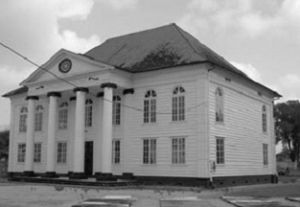B. INDIVIDUAL NAMES OF HOLOCAUST AND WAR VICTIMS SURINAME
(December 2020)
Place of birth is Paramaribo, unless noted otherwise.
| + | not with Samson (De Bye) |
| S | only/via Samson (De Bye) |
| OGS | only/via OGS |
| JM | only/via Joods Monument |
| JS | via John Stienen |
| [] | not born in Surinam |
| <> | not died in Europe |
| # | not from the war period |

Jewish names on Surinam war monument, Independance Square, Paramaribo, 2007
- JM Mathilde Judith Alberga-de Vries Robles, 6 January 1884. John Stienen informed us about this person (e-mails Nov. 2020). He was researching Jewish patients who, during the Second World War, lived in the Oude and Nieuwe Gasthuis in Zutphen. Mathildes parens were Abraham de Vries Robles, merchant (1862) and Hanna Catharina Cüster (idem). According to the website geni.com the family had eight children, Mathilde being the fifth. She married Arthur Alberga. From 23 November 1933 Mathilde Alberga stayed in the Jewish psychiatric hospital 'Het Apeldoornsche Bosch'. On the night of the 'evacuation' she was transferred by car to the Oude and Nieuwe Gasthuis in Zutphen, because she was mentioned in the administration as 'coming from Apeldoorn and probably baptised by the Reformed Church in the Netherlands Indies' (patiëntenadministratie ONG, Regionaal Archief Zutphen).
From the book by Hannah van den Ende, 'Vergeet niet dat je arts bent (2015)' (Do not forget you are a doctor) it emerges that Bernard de Vries Robles, a cousin of Mathilde, being 'rather Portugese than Jewish' received a form of exemption from the German lawyer Calmeijer. The same genealogy applied to Mathilde. Also could be suggested that, during a stay in Indonesia (Djokjakarta), where at least Bernards parents lived for a couple of years, she was baptised a Christian. She was 'on 6 April 1943 not deported when the institute was evacuated. Eventually she died on 1 January 1944 of a weak heart combined with flu' (NL-ZuRAZ, Burgerlijke Stand Zutphen, 0316, inv.nr. 2052, Nr. 3). For Het Apeldoornsche Bosch see also Simcha Monsantofils, Thelma Polak, Helena Esther Samson and Elisabeth Zinger-Root.
- + Rosetje Bramson-Samuels, 29 June 1868. For possible relatives see Netje Levie-Samuels (1862), Selly Alexander Gomperts-Samuels (1869) and the Samuels family. Her last known address was Arnhemschebovenweg 18, Driebergen. Rosetje Bramson was murdered in Sobibor, on 13 March 1943. She was 74 years old. Her name is one of the 10 Jewish civilian victims mentioned on the plaque attached to the Surinam war monument on May 4, 2006 (see Suriname in WWII).
Bibaz-Mopurgo family
- Julia Bueno Bibaz-Morpurgo, 19 April 1862, widow of Samuel Bueno Bibaz, lawyer in Surinam and interpreter/translater French and English in Paramaribo. Samuel was born on 10 July 1841 and had many other functions: he was a member of the Colonial State Council (1906-1914) and a member of the Portugeese-Jewish church council. His office was at the Heerenstraat, across the building of the Free Evangelization, who exerted themselves to convert Jews to Christianity. His wife Julia was possibly related to Willy and Ivy Morpurgo (see below). Her last known address was Overtoom 491hs, Amsterdam. There she lived with two daughters. In 1947 monthly magazine Teroenga wrote the three women were supposed to get a stamp on their certificate from the German authority in order to be, 'being Portugese Jews, protected from molest. The three of them went to the designated office and were never heard off again.' The mother was murdered in Auschwitz, on 11 February 1944, four months before her daughters. Julia Bueno Bibaz was 81 years.
- Julia ('Julie') Mathilde Bueno Bibaz, 12 December 1888, daughter of Julia Bueno Bibaz, where she lived with her sister, at the Overtoom in Amsterdam. She took her chemists diploma in Suriname. Julie was murdered in Auschwitz, on 1 July 1944. She was 55 years. Her name, Julia M. Bueno Bibaz is since 4 May 2006 on the plaque at the war monument in Paramaribo.
- Rebecca Sellina ('Betsy') Bueno Bibaz, 30 September 1890, daughter of Julia Bueno Bibaz, where she lived with her siter Julie. On the same day and place like her sister she was murdered in Auschwitz, on 1 July 1944. Betsy was 53 years.
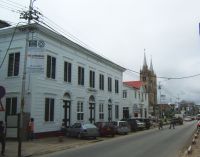
Hendrikschool Gravenstraat (Henck Arronstraat) 2007
- Estelle Cornelie Bueno de Mesquita-Bueno de Mesquita,
5 October 1880, pensioned teacher of the distinguished Hendrikschool. Estelle is the sister of Grace Julie Hilfman-Bueno de Mesquita (see below). Her last known address was Deurloostraat 104hs, Amsterdam. Here she lived with her husband and her older relative Rebecca Bueno de Mesquita. In 1941 the family of Judith Nassy-Polak also lived at this address and in 1943 Blanche Taytelbaum-Levie (see below). Estelleat this address alsos husband survived. Estelle died in Auschwitz on 26 October 1944. Estelle Cornelie was 64 years.
- JM Rebecca Bueno de Mesquita, 19 October 1876. Rebecca died in Amsterdam, a year and a half after the start of the war, on 8 December 1941. At the time she lived with her relative, Estelle Cornelie and her husband, at the Deurloostraat in Amsterdam (see above).
Bueno de Mesquita-da Costa family
- Henry David Bueno de Mesquita, 7 December 1905, son of J.A. Bueno de Mesquita, pensioned civil servant of the Government ('Chief of Immigration') and J.E. Monk, sales representative. He was married to Elina da Costa. There have been at least two children. The last known address of the familie was Acaciastraat 293, The Hague. Henry David died on 23 February 1945 in Dachau, age 39. His wife and children were already killed before he died.
- Eline Bueno de Mesquita-da Costa, 7 May 1914, wife of Henry David, daughter of J.A. da Costa and J. Robles. Eline was gassed on 8 October 1944 in Auschwitz, as were her children John and Henri. She was 30 years old. The name of Eline is with the 10 names of Jewish victims on the plaque which was unveiled in Paramaribo on May 4, 2006.
- [S] John Jacques Bueno de Mesquita, son. The Hague, 7 November 1936. Just like his mother and brother he died on 8 October 1944 in Auschwitz, 7 years old.
- [S] Henri Bueno de Mesquita, son. The Hague 7 Januari 1943. Just like his mother and brother he was gassed in Auschwitz on 8 October 1944, 1 year old.
- + Della Julietta Cahen-Tay(ij)telbaum, 28 May 1872. She was a sister of Samuel Isay Taytelbaum (Paramaribo, 28 July 1868) and an aunt to Jacobi Machiel Taytelbaum (see below). In his youth, her brother Samuel went to Europe. He lived in Amsterdam and Berlin. Back in Surinam he became a merchant and an industrialist. He died in 1939 in Paramaribo - see also his son Jacobi. Della Julietta went to Holland, where she married Samuel Louis Cahen (1864). In 1899 Louis Maurits was born. In 1924 he married Paulina Josina Tak (1902-1945). Two years later Della's husband Samuel Cahen died. Della Julietta died in the neigbourhood of Auschwitz on 22 October 1943. She was 71 years old. After the war Louis Maurits married again and lived until 1964.
- + Barend Isaac Citroen, 8 December 1875. Grocer. Possibly from the same family as Jacob Isaak Citroen and Bilha Isaak Souget-Citroen (see below). Their last address was Holendrechtstraat 45hs, Amsterdam. Barend died in Theresienstadt, less than two months before the liberation, on 12 May 1945. He was 69 years. His wife survived the war, and also one of their children.
- + Jacob Isaak Citroen, 2 July 1877. Garage keeper. Possibly from the same family as Barend Isaac Citroen and Bilha Isaak Souget-Citroen. Jacob was married to Florence Citroen-Amstell (London, 3 July 1873). Their last known address was Volkerakstraat 37hs, Amsterdam. Both were murdered in Auschwitz, two months after the start of the deportations, on 14 September 1942. He was 65, she was 69 years.
- Rachel Eleonore Antoinette (Rosette) Colaço Belmonte, 25 May 1871, daughter of Jacob Colaço Belmonte and Hanne van West. Nurse. Her last known address was Ant. Heinsiusstraat 40, The Hague. Rosette Colaço Belmonte died on 5 November 1942 in Auschwitz. She was 71 years old. N.B.: OGS and JM write her name with a cedille (ç), S and Dutch Jewry without.
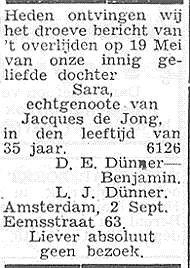
Obituary of Sara D�nner (Picture: Joods Monument)
- + Debora Esriël Dünner [Dinner]-Benjamin, 9 July 1882. Debora was married to Jehuda Leopold Dünner [Dinner], Amsterdam, 1875. Jehuda Dünner was a traveling salesman. The various sites use the name Dinner, the obituary in the Joodsch Weekblad says Dünner - see the site from Joods Monument at Hermanus Pinkhof. There were three children, among them Sara, Amsterdam, 24 April 1907. Their last known address was Eemsstraat 63-I, Amsterdam. Sara was married to Jacques de Jong. Sara died before the start of the deportations, on 19 May 1942, at an unknown place. Both parents died in Auschwitz, on 28 January 1944. Jehuda was 69, Debora was 61 years. Three children survived.
S Betsy T. Fernandes, 9 March 1893 - see Betsy Sanders-Fernandes
- JM Alexander Fernandes, 21 October 1864. In 1941 Alexander Fernandes lived with his wife at the Olympiaplein 44 hs. He died on 11 August 1942. His wife survived the war.
Fernandes-Swijt family
- Juda Daniel Fernandes, 8 May 1865 (S says 5 May), shop keeper with his own trading house. He was married to Rebecca Swijt. There were at least two daughters, Tellina Betsy (1889) and Cornelia Tellina (1896). Their last known address was Van Eeghenstraat 57hs, Amsterdam. This was a boarding house where in 1941 only Jewish boarders lived. Among them also Selly Samuels (see below). Juda Daniel was murdered in Auschwitz, on 12 February 1943. He was 77 years.
- Rebecca Fernandes-Swijt, 25 November 1870, wife of Juda Daniel Fernandes. Jansje Parra-Swijt (1884) and Celine Telline Swijt (1905) are possibly related. Rebecca was murdered in Auschwitz, on 12 February 1943. The same day and place as her husband. Rebecca was 72 years old. She is mentioned as one of the 10 Jewish civilians at the plaque of the war monument in Paramaribo, unveiled by the Surinam government on May 4, 2006.
<> # Tellina Betsy de la Fuente-Fernandes, 15 June 1989, daughter of Juda Daniel and Rebecca Fernandes. She married to E.S. de la Fuente, mayor. The couple lived in the Netherlands-Indies, where a son was born. Eduard Stephen de la Fuente, (Makasser, 9 January 1924) became a lawyer in Holland. He died on 4 March 1945 in Buchenwald. Tellina Betsy de la Fuente died on 23 June 1946 on the hospital ship Tasman, near Tandjong Priok.
Cornelia Tellina Fernandes, 14 March 1896, second daughter of Juda Daniel and Rebecca de la Fuente, is at the name of Vas Nunes-Fernandes.
- Abraham S. Fernandes
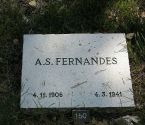  
Click to enlarge Verzetsherdenkingskruis A.S. Fernandes
(picture: OGS) (picture: www.onderscheidingen.nl) (oranjehotel.nationaalarchief.nl)
Abraham ('Bram') Samuel Fernandes, Paramaribo, 4 November 1906, son of Abraham S. Fernandes and Seline Morpurgo. In 1940 he worked at the Bataafse Petroleum Maatschappij (BPM, now Shell) as operator of the thermal cracking plant Dubbs in Pernis or Vlaardingen. In 1936 in Pernis, at the just dug Petroleum Harbour, a new Shell refinery was built. The Dubbs plant was part of it. Together with his wife and their two daughters Paula and Jetty, Bram Fernandes lived at the Sportlaan 68 in Vlaardingen. There, during the first months of the war, he came into contact with the Geuzen.
The Geuzen
The founder of the resistance group, Bernard IJzerdraat (Haarlem 1891), worked as a teacher of handicraft and calligraphy at several schools in the region of Rotterdam. The bombardement of the town (14 May 1940) and the following capitulation of the Dutch Army swung him into action. He wrote an appeal to resist, presumably named 'Bericht No. 2' (Notice No. 2), copied it by hand and distributed it as a chain letter among friends and aquantances. He wrote more Geuzen tidings and named, from July 1940 on, the handwritten paper 'De Geus van 1940' (The Geus of 1940). The name refers to the resistance in the 16th centry against the Spanish domination which lead to the independant Netherlands.
Waterweg
An aquintance of IJzerdraat, the Vlaardinger Jan Kijne, contacted Arij Kop, secretary of the walking society Flardinga. At this group, with also members in Schiedam and Maassluis, IJzerdraats appeal was immediately responded to. Many of them worked at the Wilton-Feijenoord shipyard. Others were skippers, naval employee, house painter, instrument maker, police deputy or worked, like Bram Fernandes, at companies like Shell. Alongside the Nieuwe Waterweg between Maassluis and Rotterdam, later also in Delft and other parts of South and North Holland a network started which would become the resistance group of the Geuzen. In the messages plans and instructions were passed on. After several months hundreds of people were involved with the group. Members took the Geuzen oath, which was: 'I promise, in these serious times, to be a good Dutch Geus, to obey the Geuzen law and the instructions of the commanders. If I will violate my vow in any way or another, all my assets will fall to the Geuzen army or, if not existing anymore, to the State of the Netherlands.' A radical oath, of which is unclear whether or how the conditions were enforced.
Sabotage
At some websites, like the one of the Verzetsmuseum, Go2War, the Waalsdorper Vlakte ('Erepeloton') and the 4-5 mei Comité, can be read what the resistance group accomplished. German defense networks were mapped out and passed on to London. They collected arms, made crude explosives, committed sabotage and searched for escape routes to England. They also drew up lists of NSB people (Dutch National Socialist Party), collaborators and 'Moffenmeiden' ('Kraut girls'). One can doubt how impartial these lists were. According to Go2War hardly any real sabotage was done. It remained to a limited number of actions: the light cable of the searchlight battery around Rotterdam was cut, as wel as the telephone cables of the fortifications of Hoek of Holland, and sometimes German soldiers were secretly eliminated. Jan Anderson of the Streekmuseum also relates about Vlaardingen where Geuzen cut telephone cables, thus managing the Germans to loose contact between the searchlights outside of the town and the anti-aircraft batteries inside the town. About the part of Abraham Fernandes: it is possible he was involved in the sabotage actions on the refinery, which was of great importance for the German warfare.
Arrests
In November 1940 the Sicherheitspolizei found out about the existence of the resistance group. Compared to the German secret services they were amateurishly. For instance the information about secret arms stocks in Schiedam, came to an NSB-man in Arnheim because of loose-tongued Geus belonging to the Wilton-Feijenoord group. From there they found out about the names of the Geuzen at Wilton-Feijenoord and the walking society Flardinga. On 28 November Bernard IJzerdraat was arrested in Haarlem. In his home guns and addresses were found. In December, January and February the arrests continued. On 24 Februari 28 people were next, among them Bram Fernandes. A girl next door, Joke Petterson, saw a black car entering the street on 24 February 1941. 'Oncle Bram' was taken away and went, like all other members of the resistance group, to the Scheveningen penitentiary, later on called 'the Oranjehotel'. Often the Germans tried to get information from them by torture.
Indictment
On the same day 43 Geuzen were brought before the German military court in the building of the Dutch Law Lords (The Hague), called the 'Feldgericht des Kommandierenden Generals und Befehlshabers im Luftgau Holland'. Apparently the accused were, as they considered themselves as well, treated as a (Geuzen) army. They were among other things accused of espionage, posession of arms and damaging of military equipment.
Death
It is not known if Fernandes was also apprehended on the base of this indictment. A week after his arrest, on 4 March 1941, he died in the Scheveningen prison, probably due to torture. He was 34. Another Geus, Ko Boezeman from Maassluis preceded him in the same way on 9 January. Without trial or sentence.
Executions
On the same 4 March 1941 the sentence of the Feldgericht in the official Geuzen trial was: eighteen death penalties, nineteen times imprisonment and six times exoneration. This was an enormous shock to the prisoners. The lawyers put in a petition for clemency and believed it would be granted. But on 11 March 1941 general Christiansen ratified the verdict for fifteen of the death sentences. Two days later the verdict was carried out. Three communists who were arrested during the February strike (25 February) were added to the group of fifteen, making the total eighteen men. Among them both Joop Eyl and Bram Fernandes were Jewish. The men were transported to the Waalsdorpervlakte in the dunes in trucks and executed by firing-squad. It was the first of a series of executions to take place on this lowland.
Resistance poem
As a reaction Jan Campert wrote his poem 'De achttien doden' (The eighteen dead), with the famous first lines 'A cell is but two meters long, and hardly two meters wide, even smaller still is the patch of ground, which I don't know yet, where I will rest nameless'. Early 1943 the underground press (De Bezige Bij) made it into a rhyme print. The returns were to the benefit of saving Jewish children. Ko Boezeman and Bram Fernandes, and maybe some others, can symbolically be reckoned among these eighteen dead.
Continuation
After the death of Abraham the Fernandes family immediately left Vlaardingen, to Amsterdam or Halfweg. The family survived the war and the possible consequences of involvement with the Geuzen resistance and the persecution of Jews. Abraham Fernandes posthumously received the Verzetsherdenkingskruis and was reburied at the Dutch honorary cemetery Loenen near Apeldoorn (nr. 160). His name is (possibly twice) on the resistance plaque which was unveiled by the Surinam government on 4 May 2006.
Commemorations
Siebe Idzinga grew up in the Vlaardingen house where the Fernandes family lived and accidentally heard about an appeal by the former girl next door Joke Petterson. He wanted to know about what happened and collected a lot of information which was part of a lecture on 24 February 2009 and a publication by the Streekmuseum. The Geuzenverzet 1940-1945 foundation will dwell on the part played by Abraham S. Fernandes in the resistance during the presentation of the Geuzenpenning (Geuzen medal) on 13 March 2009.
Gravestone Vlaardingen
Jan Anderson, employee of the Streekmuseum Vlaardingen and Geuzen connoisseur, thinks there should be a gravestone for Fernandes at the Emmaus Cemetary. At this cemetary six Vlaardingen Geuzen are buried. Also there are nine gravestones for Geuzen buried elsewhere in Holland.
Sources:
- Vinny Talor, Vlaardingen eert vergeten Surinaamse verzetsheld, 5 januari 2009 http://surinaams.caribiana.nl/innederland/car20090105_fernandes-verzet)
- Algemeen Dagblad 23 december 2008
(www.ad.nl/rotterdam/waterweg/2866522/Erkenning_voor_Surinaamse_Geus.html)
- De Weekkrant 12 maart 2008 (www.deweekkrant.nl/files/pdfarchief/NS/20080312/NS_NS-1-36_080312_2.pdf)
- Liesbeth van der Horst, Wereldoorlog in de West, p. 140
- www.oranjehotel.org/namen/doodenboeken/namen_Doodenboeken.htm
- www.voeks.nl/Nieuws/j52e09.htm (Dubbs-installatie)
- http://nl.wikipedia.org/wiki/Het_lied_der_achttien_doden
- Verzetsmuseum (http://www.verzetsmuseum.org/tweede-wereldoorlog/nl/achtergrond/achtergrond,geuzen_bezige_bij)
- Hans Molier, De fusillade van achttien mannen op de Waalsdorpervlakte op 13 maart 1941 (www.go2war2.nl/artikel/1074/Achttien-doden-op-de-Waalsdorpersvlakte.htm).
Gomperts-Samuels couple
- David Coenraad Gomperts, 21 May 1863 (S says 22 May, De Bye writes in 'Outlines' 20 May), doctor, owner of the plantation Ma Retraite. He was a district doctor in the areas Upper-Para and Saramacca. In 1902 he was honourably dismissed because of his years in the tropics. He devoted himself to the management of his plantation. For a short time he also was a member of the Pauper Board of the Netherlands-Israelite Congregation (NIG). In 1934 Gomperts was knighted into the Order of Oranje-Nassau. The site of JM writes, based on the study of J.H. Coppenhagen, the following: 'David Coenraad Gomperts (also spelled Gompertz) studied medicine in Paramaribo. He passed his doctors exam in 1889. He settled down in Holland in 1914, in The Hague at the Groot Hertoginnelaan 248, as doctor emeritus. He was director of the Cultuurmaatschappij (Society of Culture). David Coenraad Gomperts was married to Selly Alexander Samuels'. Their last known address was Groot Hertoginnelaan 243. David Coenraad was gassed in Sobibor on 7 May 1943, as was his wife. He was 80 years old.
- Selly Alexander Gomperts-Samuels, 22 Januari 1869, wife of David Coenraad Gomperts. For possible relatives see Rosetje Bramson-Samuels (1868), Netje Levie-Samuels (1862) and the Samuels family. Mrs. Gomperts-Samuels was gassed in Sobibor on 7 May 1943, just like her husband. She was 74 years old. Three relatives of the couple survived the Sjoa.
- Cosman ('Cos') Abraham Gomperts, 13 October 1889 (S writes 1898), son of A.S. Gomperts and Rosette Leefmans. Doctor. The site of Joods Monument writes, based on J.H. Coppenhagen, the following: 'Cosman Abraham Gomperts (also spelled Gompertz) studied medicine in Groningen. He passed his doctors exam in on 26 November 1925. He lived and practiced in the Gabriël Metsustraat 32, Amsterdam.' De Metsustraat 32hs also was his last known address. Doctor Cos Gomperts died on 1 October 1944 in Auschwitz, at the age of 46. His wife and one child survived.
- Daniel Eliazer Gomperts, 5 December 1898, son of Eliazer C. Gomperts and R. Abarbanel. He married to Charlotte Fanny Hamburger, born in Delft, on 16 August 1889. The couple had a shop. Their last known address was: Utrechtschestraat 39hs, Amsterdam. Both were gassed on 5 March 1943 in Sobibor. Daniel was 44 years, Charlotte 53 years. The name Daniel E. Gomperts is since 4 May 2006 on the plaque of the war monument in Paramaribo.
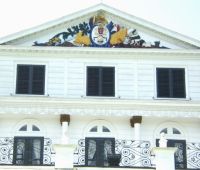
Palace Governor (president) Oranjeplein (Independance Square) 2007
- Samuel Henriquez de Granada, 17 July 1873, (S writes Hendriques). Mr Henriquez had a distinguished career with the government. In 1892 he started as a surplus civil servant at the registry of the Colonial State Council. A family member, Jacques Henriques de Granada (1835), had been the first registrar and stayed so until his death in 1892. Within less than four years later Samuel was a district registrar, and in October 1903 clerk at the Immigration Department. The department arranged recruitment, distribution, protection and possible return of contract workers from the British and the Netherlands Indies. From 1906 (deputy), 1909 (final) until 1921 het had the function of district commissioner (mayor) of the district Lower-Commewijne. In June 1921 he was made, as the oldest district commissioner, deputy Agent-General for Immigration, thus head of the department. During those years immigration itself became less and less important. Meanwhile also a real Surinam member was wanted for the Council of Suriname, and in May 1922 he became a member. On the first of January 1925 his appointment as Agent-General was made definitive. During the same year Samuel went on leave to Holland. He did not return to Suriname. His last known address was Sweelinckplein 73, The Hague. Samuel Henriquez de Granada died in the Czech camp Theresienstadt, on 11 Augustus 1944. He was 71 years.
Extra source: wikipedia
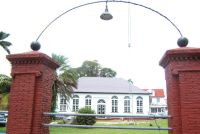
Portugese-Israelite Synagogue Heerenstraat 2007
Hilfman-Bueno de Mesquita family
[] + OGS Pinkus (Bernard) Hilfman (Aalten, 23 January 1877) (Pincus A. Hilfman at De Bye, Outlines), was during 20 years religious teacher and talmud scholar of the Portugese Israelite Congregation in Paramaribo (PIG). In this function he succeeded David de Isaac Querido (1893-1896; see Rebecca Querido). Hilfman was born in an orthodox background in Aalten. As well his father as his grandfather (mothers side) were talmud scholars. He went for his study to the Netherlands-Israelite Seminar in Amsterdam, where in 1901 or 1902 he obtained his diploma as a religious teacher. On May 1 1901 he left for Suriname to practice his profession. His first sermon was attended by the governor. In the same year Hilfman attrackted yellow fever, but he recovered. On 24 December he married Grrace Julie Bueno de Mesquita, whom he had met in Paramaribo. His colleague from the Ashkenazy Congregation (NIG), Jacob Roos, celebrated the marriage. The couple had three children (see below). Pinkus Hilfman published a lot, among it 'Notes on the history of the Jews in Suriname'(1909). In 1922 he was pensioned, because of his years in the tropics. The family returned to Holland and initially lived in The Hague. After that they also live in Antwerp and in Amsterdam. Pinkus Hilfman died 27 January 1943 in Amsterdam, and was buried at the Jewish cemetary in Diemen. He became 66 years. On the site of JM the following announcement of death of the Joodsch Weekblad can be read.
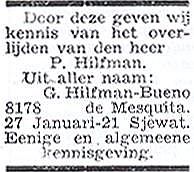
Anouncement of death of Pinkus Hilfman (Picture: Joods Monument)
- S Grace Julie Hilfman-Bueno de Mesquita, 9 August 1879. Grace Julie was the wife of the religious teacher of the Portugese-Jewish Congregation (PIG) and a younger sister of Estelle Cornelie Bueno de Mesquita (see above). The couple Hilfman-Bueno de Mesquita had three children, among them son Rudolf.
Granddaughter Moana Hilfman, daughter of Rudolf, writes in an e-mail (2005) the following:
'In the typed statement given by the Dutch Red Cross of 20 January 1948, it is declared that my grandmother, 'Grace Julie Hilfman-Bueno de Mesquita, born 9 August 1879 in Paramaribo, last address: Pres. Brandstraat 24hs in Amsterdam, was put on transport to Theresienstadt on 25 February 1944. - Op 16 May 1944 she was transported on from Theresienstadt to the destination Auschwitz. - [...] furthermore declares, that the persons, who were deported from Theresienstadt on the 16 May 1944 to Auschwitz, until about the beginning of July 1944 died by the the consequences of gassing in or around Auschwitz. - [...]'
Grace Julie Hilfman-Bueno de Mesquita lived 64 years. Her son Rudolf and his wife (see below) were killed a year before she died.
The name Grace Julie Hilfman was not mentioned on any of the known Holocaust victims websites. Since September 2005 both spouses are inserted on the site of the Oorlogsgravenstichting.
- Rudolf Hilfman, 1 March 1906, son of Pinkus and Grace Julie Hilfman. Traveling salesman. He was married to Jochébed Henriette Hilfman-Levisson, Amsterdam, 13 March 1908. Their last known address was Blasiusstraat 113-III, Amsterdam. Both spouses were gassed in Sobibor on 2 July 1943. Rudolf was 37 years, Jochébed 35 years. Their daughter Moana survived.
Mrs. Moana Hilfman declared in an e-mail (2005) the following:
'My father, Rudolf Hilfman, one of the three children of Pinkus Hilfman and Grace Julie Bueno de Mesquita, was deported to Sobibor on 29 June 1943 and died there on or about 2 July 1943. In his last passport, in my posession, he is mentioned as a 'traveling salesman'.'
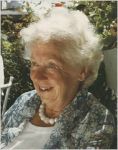
Johtje Vos in the 1990s (Picture: The New York Times)
In the New York Times of 4 November 2007 more can be read about the Hilfman-Levisson family. Barbara Moorman (Glenford, NY) tells how her mother Johtje Kuyper (journalist, granddaughter of statesman Abraham Kuyper) and her second husband, Aart Vos, during the war in their house in Laren, saved 36 Jewish Dutch persons. Johtje also wanted the Hilfman-Levisson family to go in hiding at their place. Moana's parents refused though. They said: 'we are Jews; this is our fate'. Johtje Vos begged them to at least give their 3 year old daughter a chance of survival. In the night Rudolf and Jochébed were taken away, they gave Moana to a friend, who brought her to the Vos couple. Moana Hilfman was raised as one of their own children and survived.
[With thanks to John Brouwer de Koning]
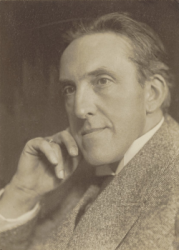
Adriaan van der Horst (Source: afbeeldingen.gahetna.nl)
- JM Betsy Nelly van der Horst-Polak, 9 June 1886. Betsy was the daughter of Victorina Polak-Pinto and the sister of Herman Polak (see below). In 1929 she married the famous Dutch director, actor en theatre critic Adriaan van der Horst (Dordrecht, 19 July 1868 - Amsterdam, 14 June 1942), though she did not originate from the world of the arts herself. Adriaan's first wife, the actrice Wilhelmina van der Lugt Melsert, died in 1928. At that time she played with the Haarlem theatre company Schouwtooneel, where Adriaan was director. When this company went broke in 1933 Van der Horst became administrator of the Rotterdamsch-Hofstadtoneel, which was managed by his brother in law Cor van der Lugt Melsert until it closed down in 1938. On 27 July 1929 Betsy Polak moved to her husbands house at the Van Baerlestraat 150, top. According to the biographer of Van der Horst she 'took care of the aging man very well'. In fact the parents of Betsy moved in with their daughter and son in law, so in 1935 a complete family lived at the address. Betsy's father died in 1938.
The mixed marriage somewhat protected Betsy when the war broke out. But she died on 29 January 1942, five months before her husband. Betsy van der Horst was buried in the grave of Wilhelmina van der Lugt Melsert and where in June 1942 also Adriaan van der Horst was layed to rest (Zorgvlied N-I-1249). Her mother Victorina Polak was deported and died in March 1943 in the destruction camp Sobibor.
Sources:
- Digitaal Joods Monument and Community
- Family card City Archives Amsterdam
- www.dbnl.org/tekst/_jaa003194501_01/_jaa003194501_01_0007.php (J.L. Walch on A. v.d. Horst)
- E-mail Kees Buisman, Zorgvlied (27 June 2013)
- Picture: http://afbeeldingen.gahetna.nl
- + Sophie Louise Jacobsen-Samson, 7 July 1885. She was a daughter of Jacob Marcus Samson en Hester/Estelle Elisabeth Samethini and a sister of Flora Marianne Samson (1875), Judith de la Parra-Samson (1884), and Helena Esther Samson (1886).
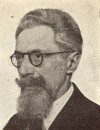
Leopold Bernard Jacobsen (picture: Joods Monument)
Sophie Louise Samson married to Leopold Bernard Jacobsen (Meppel, 11 October 1879), liquor manufacturer. He was an enthousiastic member of the chess club 'Discendo Discimus' in The Hague. Leopold wrote the club song and, on festive occasions, recited poems (www.joodsmonument.nl). The couple had at least three children; Emmy, Margo and Rudolf. In 1942 one of them still lived at home. Their last known address was the Zeestraat 73 in The Hague. On 12 February 1943 both were gassed in Auschwitz. Sophie Louise was 57, her husband 63 years. The three children survived. One of them was in hiding, one had a mixed marriage and the other lived abroad.
[With thanks to Helmus Liekele, e-mail March 2009, and John Stienen, e-mail November 2021]
Kopinsky brothers
- Salomon Eduard Kopinsky, 17 August 1897, son of Selig Kopinsky and Elisabeth Nunes. He was married to Sara Morpurgo (Amsterdam, 3 December 1894). There were two daughters, Elisabeth (Amsterdam, 16 April 1922) and Gracia (idem, 19 August 1926). Their last known address was Dijkstraat 45-II in Amsterdam, near the Nieuwmarkt. At the time Salomons' profession was merchant, Elisabeth was a trouser seamstress. Gracia was a student off-the-peg worker. The family members were murdered on different dates. Both daughters in Auschwitz, shortly after the beginning of the deportations. Elisabeth on 18 September 1942, 20 years old. Gracia on 30 September 1942, 16 years old. Eight months later, on 28 May 1943, Sara was gassed in Sobibor. She was 48. Salomon died, like his brother Seling, on 31 March 1944 in Central Europe, at the age of 46. There's a JOKOS-file of the family: a claim on the Federal Republic of Germany for robbed furnishings.
- Seling/Celig Kopinsky, 24 May 1908, younger brother of Salomon Eduard. He was married to Henriette Logcher (Amsterdam, 7 September 1914). Both were office clerks. There was one child, Nick (Amsterdam, 17 Augustus 1935). Their last know address was the Niersstraat 18-I in Amsterdam, River quarter. Nick was gassed together with his mother on 22 October 1943 in Auschwitz. She was 29 years, he was 8 years. Seling died at the same time and place as his brother Salomon, 31 March 1944 in Central Europe. He was 35 years. A JOKOS-file is know of the family: a claim on the Federal Republic of Germany for robbed furnishings.
- Leonard ('Leo') Kopinsky, 10 December 1909 (DJ and JM mention 10 February instead of 10 December), younger brother of Salomon and Seling. His last known address was Rijnstraat 207-III in Amsterdam. Leo's profession was tailor. He died at the end of the war in camp Dachau, on 23 March 1945. Leonard was 35 years old.
- Sophie de Lange-Salomons, 14 April 1911, daughter of Abraham Salomons, merchant and Reinie Pos. She married to Elias Johan de Lange (Amsterdam, 8 March 1907), construction engineer. There were two children. Their last known address was J.W. Brouwersstraat 15hs, Amsterdam, near the Concertgebouw. Sophie died on 3 September 1943 in Auschwitz, at the age of 32. Her husband died seven months after her in the same camp, on 31 March 1944. He was 37 years. The children survived.
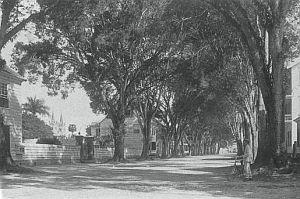
Heerenstraat, Paramaribo (Picture: webserv.nhl.nl)
Left the entrance gate to the Portugese synagogue, behind it the towers of the cathedral
Leefmans-Ballin family
- Helene Elise Leefmans-Bal(l)in, 29 March 1859, widow of Leefman Cos Leefmans, merchant; daughter of Barnat Ballin and Rebecca Bueno de Mesquita. She was married in Paramaribo. Her last known address was Frans van Mierisstraat 77hs, Amsterdam. Her cousin Elisabeth Lyons lived in the adjacent Ruysdaelstraat (see below). Helene Elise lived together with her daughter Estelle (see below). Both were deported to Bergen-Belsen. Mrs. Leefmans-Ballin died there on 8 May 1944, 85 years old.
- Estelle Rachel Leefmans, 21 August 1888, daughter of Cos and Helene Leefmans. In 1941 she lived with her mother in the Frans van Mierisstraat in Amsterdam. Estelle was blind. On 27 March 1944 she died in camp Bergen-Belsen, six weeks before her mother. Estelle Rachel was 55 years.
(with thanks to Mrs. Anne E. Otto, great-granddaughter of Helene Elise Leefmans, Sept. 2006)
De Leon(-Fernandes) sisters
- Wilhelmina Hilda ('Leonie') de Leon, 30 October 1898, daughter of Isaac de Leon and Esther J. Fernandes. Nurse. Her last known address was Hectorstraat 35hs, Amsterdam, where she lived together with her sister Georgine. Just like her sister Leonie de Leon died on 31 December 1944 in Auschwitz. She was 46 years.
- Georgine Elizabeth Heloise de Leon, 10 January 1902, younger sister of Leonie de Leon, also a nurse. Her last known address was her sisters house. Georgine died at the same day and place as her sister, on 31 December 1944 in Auschwitz. She was 41 years.
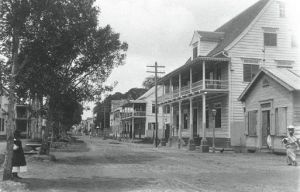
The Keizerstraat in Paramaribo, where the High-German synagogue was (Picture: webserv.nhl.nl)
Levie-van der Rhijn family
- Hartog Salomon Levie, 20 December 1869. Husband of Flora van der Rhijn, Groningen 27 December 1863. First the couple lived in Suriname, where daughter Louisa was born (see below). Their last known address was Oosterpark 76, upper appartment, Amsterdam. Hartog Salomon and Flora Levie were gassed in Sobibor on 16 April 1943. He was 63, she was 69 years old.
- + Louisa ('Louise') Levie, 2 January 1898. Daughter of Hartog Salomon and Flora Levie-van der Rhijn. Her last known address was at her parents', Oosterpark 76 in Amsterdam. Her date of decease (Sobibor, 6 April 1943) is a mistyping. Louise was brought to Westerbork on the 2nd or 3rd of April 1943 after betrayal (?). The date of 6 April, which is used by www.ogs.nl and Joods Monument was the day of deportation. She was gassed on the 9th of April. Louise was 44 years.
With thanks to Mr. Pinchas Bar-Efrat (September 2007)
Levie-Levie couple
- Salomon Hartog Levie, 19 August 1896, by S mixed up with the older Salomon Israel Levie (9 April 1892) - see below. Salomon Hartog probably was a son of Hartog Salomon Levie (see above). Salomon Hartog married to Julie Levie. The couple had a shop at the Kalverstraat 94. He was murdered on 7 September 1943 in Auschwitz, at the same place and time as his wife. Salomon Hartog was 46 years.
- Julie Mathilde Levie-Levie, 11 July 1901, daughter of Isaak J. Levie and Esther E. Pinto (not the wife of Salomon Israel like S assumes), but of Salomon Hartog Levie. The couple had a shop at the Kalverstraat. Julie Mathilde was gassed on 7 September 1943 in Auschwitz, the same place and time as her husband. She was 42 years. Her brother Juda and his family also could not escape.
Levie-Blog family
- Juda Israel Levie, 22 February 1899, older brother of Julie M. Levie (see above). He was department manager of the department store De Bijenkorf in Rotterdam and deputy manager. Juda was married to Mietje Levie-Blog (Amsterdam, 23 October 1897). The couple had a child, Fritz Jack, born in Amsterdam (22 June 1928). Their last known address was the Van der Palmstraat 61 in Voorburg. The familiy was betrayed (?) and sent to camp Vught. From there they werd sent to Westerbork on the 24th of May 1943, and from there 'sent on'. On May 28, 1943 Juda (44 years), Mietje (45 years) and Fritz (14 years) were gassed in Sobibor. 2,844 other jews from Holland died there on that same day. The date of death 28 May 1944 from the database of DutchJewry and the Joods Monument, must be a mistake. Dutch transports to Sobibor ceased on 23 July 1943.
With thanks to mr. Pinchas Bar-Efrat (September 2007)
Levie-Samuels family
- + Netje Levie-Samuels, 2 March 1862, widow of Israel S. Levie, mother of Salomon Israel Levie and, by the spelling of the second first name, probably also of Aron Isriël, Marcus Israel and Bernard Isriël Levie (see below). She is mentioned by S but he does not mention her as a victim. For possible relatives see Rosetje Bramson-Samuels (1868), Selly Alexander Gomperts-Samuels (1869) and the Samuels family. Her last know address was Uithoornstraat 37-I in Amsterdam. There she lived together with the couple Leuw and the Hoogstraal family. Netje Levie-Samuels was murdered in Auschwitz on 26 February 1943, four weeks after her son Salomon and grandson Isriël. Netje was 80 years.
- Salomon Isriël/Israel (with S) Levie, 9 April 1892. Mentioned by S as son of Israel S(alomon) Levie and Netje Samuels. S writes 10 April and mixes him up with Salomon Hartog Levie (19 August 1896). The Joods Monument gives no second first name. Salomon Isriël Levie was a pastry cook. He married to Anna Sjouwerman (Amsterdam, 27 June 1892). The couple had two children: Isriël Salomon (Amsterdam, 28 February 1927) and Theodoor Salomon (idem, 31 July 1928). Their last known address was the Tweede Boerhaavestraat 66-II in Amsterdam. Anna Levie-Sjouwerman and the youngest son, Theodoor Salomon, died on 24 September 1942 in Auschwitz, two months after the start of the deportations. Anna was 51 years, Theodoor was 14. Salomon Isriël and the eldest son Isriël Salomon have 31 January 1943 as date of death. They were 46 and 15 years old.
- Aron Israel/Isriël (with S) Levie, 4 July 1896, brother of Salomon Isriël and Marcus Israel Levie. Aron was shoemaker. He married to Duifje Engelander (Amsterdam, 22 April 1890). There were two children: Jeannette (Amsterdam, 14 November 1924) and Rosa (idem, 20 April 1929). Their last known address was the Tweede Jan Steenstraat 56-II in Amsterdam. The parents and the youngest daughter were murdered in Auschwitz on 15 December 1942. The eldest daughter almost three months earlier, on 30 September 1942. Aron Isriël was 46, Duifje 52, Jeannette 17 and Rosa 13 years old.
- S Marcus Israel Levie, 9 October 1900, brother of Salomon Israel Levie (see above). His name is not mentioned on the sites of OGS, JM and In Memoriam.
- Bernard Isriël/Israel (with S) Levie, 13 October 1902, brother of Salomon Isriël, Aron Israel and Marcus Israel Levie. He married to Helena Nathan (Arnhem, 23 November 1900). There were no children. Bernard was a traveling salesman. Their last know address was Rozengracht 70hs in Amsterdam. The couple was gassed in Sobibor on 2 July 1943. Bernard Isriël was 41, his wife Helena 42 years. The name of Bernard Israel Levie is in the list of 10 Jewish victims at the plaque on the war monument in Paramaribo (see Surinam in WWII).
Levie sisters
- Sara Celine Levie, 25 July 1889 (S writes 8 July). Housemaid. Her last known address was Uithoornstraat 51-I in Amsterdam. It is possible Sara Celine was related to Netje Levie-Samuels and her sons named above. Netje Levie lived in the same street, at number 37-I. Sara lived together with her family members Betje and Rosette. All were gassed on 3 December 1942 in Auschwitz. Sara Celine was 53 years.
- Betje Levie, 21 October 1890. Bookkeeper. She lived together with Sara and Rosette Levie, probably sisters, at the Uithoornstraat 57-I in Amsterdam. Betje was, just like her relatives, gassed in Auschwitz on 3 December 1942. She was 51 years.
- Rozette/Rosette (with S) Levie, 11 March 1894. Saleswoman. The youngest of the three relatives at the Uithoornstraat 57-I. With them in 1941 also lived Salomon Meijer Swaab, twin brother of Rebecca Swaab, who lived with her parents at the Uithoornstraat nr. 87-I. Rozette Levie was gassed on 3 December 1942 in Auschwitz, like Betje and Sara. She was 47 years. Salomon Meijer Swaab, his sisters and their parents were already murdered before them in the same camp. Rozette Levie is mentioned at the plaque of the war monument in Paramaribo.
- S Henriette Levie, 18 January 1899.
Her name is not mentioned on the sites of OGS, JM and In Memoriam. She died on 21 October 1962 in Amsterdam.
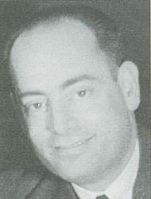
Willy Albert Levy (picture: Joods Monument)
- + Willy Albert Levy 1 December 1899. Surgeon (see H. Coppenhagen). His last known address was Frans van Mierisstraat 82hs, Amsterdam. Doctor Levy served as a reserve-officer of the Medical Troups in the May days of 1940, engineers unit. He died on 15 May 1940 in Amsterdam, and was buried at the Dutch-Israelite cemetary at Muiderberg (row 25, nr. 35). His wife, Helena Martha Frijda (Assen, 26 March 1905) died on the same day and was buried at the same cemetary, next to her husband (nr. 36). It is likely both choose their own death. This is confirmed by Joods Monument. It states that Levy was reserve-officer of health. He and his wife possibly could not live with the victory of the nazis. As a doctor he had the means to do this. About 250, mostly prominent Jews, took this decision in May 1940.
- Betje Lopes de Leaô Laguna-da Silva, 7 August 1882 - The site of OGS writes no sign on the o of 'Leao'. Widow of B.J. Lopes de Leaô Laguna and sister of Isaac David and Arnold da Silva (see below). Her last know address was G. Terborgstraat 17hs in Amsterdam. Her daughter Hettie, born on 18 December 1907 in Watergraafsmeer, lived with her. Hettie was a beautician. She was murderend on 17 September 1943 in Auschwitz, at the age of 35. Her mother Betje was killed on 7 July 1944 in Auschwitz, the same day as her brother Isaac David da Silva and her sister in law Anna da Silva-Palache (see below). The same day also Rebecca Lopes de Leaô Laguna (Amsterdam, 3 October 1883) died, piano teacher, and probibly a relative. Betje was 61 years old.
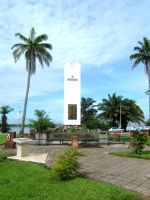
Monument war victims, Waterkant/Independence Square 2007
- + Elisabeth Estelle Lyons [Lijons], 15 February 1871, daughter of Juda Lyons (1836) and Johanna Leefmans (1862). Her last known address was Ruysdaelstraat 102-II in Amsterdam. Her aunt and one of her cousins - Helene Elise Leefmans-Bal(l)in and her daughter Estelle (1888) - lived in the adjacent Frans van Mierisstraat 77hs. Helene Leefmans was the sister in law of Elisabeths' mother. Elisabeth Lyons was gassed in Sobibor on 14 May 1943 together with 1,364 other Jews from Holland. She was 72 years. Her stepsister Marie Evelyne (13 december 1895) survived and became almost 100 years. She died on 2 December 1994 in Amsterdam. (With thanks to Mrs. Anne E. Otto, great-granddaughter of Helene Elise Leefmans, September 2006)
- JM Simcha Alexandrina Monsatofils, 2 April 1972, daughter of Hendrik Alexander Monsantofils and Sally Heilbron. She was the eldest of five children, who all bore the name Alexander. After her there were four brothers: Alexander Aron Philip (1873), Abraham Alexander (1875), Alexander Egbert Maurits (1879-1898, drowned) and Alexander Isack (1882). Sally Monsantofils-Heilbron died in 1892. Simcha went to the Netherlands. She died on 4 December 1940, at 21.45 hrs, as a patient of the 'Apeldoornsche Bos' institute. Two days later assistant porter Abraham Polak registered her death with the city of Apeldoorn.
Sources:
- Digitaal Joods Monument and Community
- www.network54.com/Forum/133847/thread/1046006602/last-1166739964/zoek+info+monsantofils
Her name is not mentioned at the sites of the War Graves Foundation and DutchJewry (May 2013).
Morpurgo-Alberga children
- Willy Albert Morpurgo, 16 December 1899, son of Jacques Morpurgo and Annie Alberga. Probably related to Julia Bueno Bibaz-Morpurgo (see above). Willy was a waiter. His last known address was Willemstraat 22 in Utrecht. Willy died on 1 Februari 1943 in Auschwitz, at the age of 43. Around that time also died his brother in law Michel Fregge (see below).
[] S Ivy Gerharda Fregge-Morpurgo, Amsterdam, 19 November 1906. According to De Bye she was a sister of Willy Albert. She married the nurse Michel Fregge (Amsterdam, 24 October 1903). The couple had six children: Leo (30 November 1929), Annie (20 November 1930), Jack (22 May 1932), Mia (9 November 1932?), Albert (7 August 1935) and Netty (22 January 1937). Probably 1932 is a mistyping with Mia of 1933 or 1934. Their last known address is the President Brandtstraat 50-II in Amsterdam. They lived there together with another large family, Harpman-Levie, with five children. Ivy Gerharda and her six children were all gassed on 24 September 1942 in Auschwitz, two months after the start of the deportations. Ivy Fregge-Morpurgo was 35 years, the children 12, 11, 9, 8 of 7, 6 and 4 years. Michel Fregge died in the same camp on 31 January 1943, arond the same date as his brother in law Willy Morpurgo. He was 39 years old.
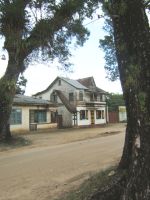
End of J.F. Nassystraat 2007
- JM Jacques George Nassy, 27 April 1891. The site of Joods Monument writes: 'Jacques George Nassy studied medicine in Amsterdam, where he passed his doctor's exam on 21 February 1917. He promoted on 10 June 1918 in Amsterdam on a dissertation about 'preservation of 'virus fixe' in order to fight rabies in the tropics'. Jacques George Nassy was officer of health 1st class in the Royal Netherlands-Indies Army (KNIL). He was a general practitioner in Amstelveen (Nieuwer-Amstel).' Jacques George died on 11 June 1942 in Amstelveen, 51 years old.
Nassy-Polak family
- Judith Louise Nassy-Polak, 4 August 1892. She was the widow of 'Joost' Nassy, son of Samuel Henry Nassy and Judith Robles. She probably was a sister in law of doctor Jacques George (see above) and sister of doctor Maurice Samuel Polak (see below). Her parents were Samuel Maurits Polak and Esther Elizabeth Gomperts. Three children are known of the couple Nassy-Polak: Henry Jules (Paree, 7 April 1925) - Paree is on East-Java -, Lygya Esther (idem, 20 May 1926) and Rachel Rebecca (idem, 1 March 1931). In August 1941 Henry was at the second profession school in Amsterdam. Their last known address was Deurloostraat 104hs in Amsterdam. In 1941 there also lived the couple Bueno de Mesquita-Bueno de Mesquita (see above) and in 1943 Blanche Taytelbaum-Levie. Judith Louise and her daughters Lygya Esther and Rachel Rebecca were gassed on 28 May 1943 in Sobibor, 50 years, 17 years and 12 years old. Henri Jules died eight weeks later in the same destruction camp, on 23 July 1943. He was 18 years old.
- Leo Jacob Nassy, 11 July 1924, son of Jacob Nassy and Seline Gomperts. His address in Holland is not known. He was gassed on 2 July 1943 in Sobibor. Leo Jacob was 18 years old.
De la Parra-Swijt family
Three of the 11 who carry the name De la Parra on the OGS-victim list are born in the Netherland-Indies, 2 children and 1 youngster in the Netherlands. Also the other family names of victims are as well from Suriname, The Netherlands, as from the Netherlands-Indies.
- Marinus Alfred de la Parra, 12 November 1878, dermatologist. Marinus de la Parra studied medicine in Utrecht, where he passed his doctor's exam on 27 November 1908. He specialized in skin and venerial diseases. In Paramaribo he married to Jansje Swijt; Henri Jacques ('Hans'), Herman Marinus and Max are their children (see below). After the first world war the family moved to Amsterdam. Marinus Alfred de la Parra lived and had a practice at the Sarphatistraat 97 in Amsterdam and also had a practice at the Lutmastraat 7 and the Marnixstraat 321 and, only for Jewish patients, in 1942 at the Noorder Amstellaan 123 (see J.H. Coppenhagen, Anafiem Geoe'iem. 'Overleden joodse artsen uit Nederland 1940-1945' (Deceased doctors from the Netherlands 1940-1945)).Their last known address was De Lairessestraat 115 in Amsterdam. Marinus Alfred de la Parra and his wife died on 30 October 1944 in Auschwitz. He was 65 years old.
- Jansje ('Jeannette') de la Parra-Swijt, 21 June 1884, wife of Marinus Alfred, mother of Henri Jacques, Herman Marinus and Max. She was probably related to Rebecca Fernandes-Swijt (1870) and Cornelia Tellina Vas Nunes-Fernandes (1896) and Celine Telline Swijt (1905). Jansje de la Parra-Swijt died at the same place and date as her husband. She was 60 years.
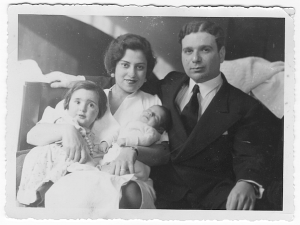
De la Parra-de Vries family (picture: Joods Monument)
- Henry ('Hans') Jacques de la Parra, 22 April 1907, son of Marinus Alfred and Jansje de la Parra. Dentist. On the 28th of August 1934 he married Helene Marianne ('Enny') de Vries (Amsterdam, 10 March 1915). Her parents were Samuel de Vries, diamond trader, and Alida Vieijra. The happy couple had two children: Myrna Jeannette (Amsterdam, 5 January 1936) and Glanda (also 'Glenda') Marianne (idem, 19 February 1938).
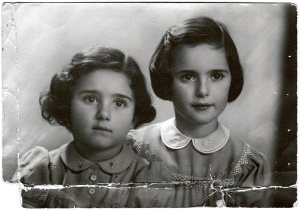
Glanda and Myrna de la Parra (ca 1940) (picture: In Memoriam, p.743)
Deportation
Their last known address was Beethovenstraat 118hs, Amsterdam. On 20 June 1943 the last big raid on Jews in the south of Amsterdam took place. Maybe fate struck earlier or later. The family ended up in camp Westerbork. From there Hans, Enny, the girls and grandma De Vries were deported to the relatively privileged Theresienstadt. Philip Mechanicus writes in his Westerbork diary: 'Meanwhile this morning, the delayed transport to Theresienstadt left: eight hundred men, women and children. This time there was a sort of run on the train, a third class train. The rumour was spread that those, who were not gesperrt ... and did not take this chance, would definitely end up in Auschwitz the next time.
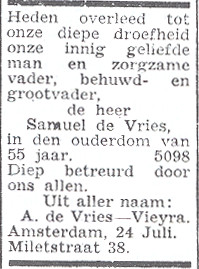
Joodsche Weekblad 31-7-1942, obituary Samuel de Vries
www.joodsmonument.nl/person/525469
From Theresienstadt though, transports regulary left for Auschwitz and other camps. On 1 October Enny, her two daughters and her mother arrived in Auschwitz. At the selection Enny was separated from them. She was to line up for labour, Myrna, Glanda and Alida were to line up for the gas chamber. The daughters, 8 and 6 years, were murdered the same day, on 1 October 1944 in Auschwitz, four weeks before their grandparents on their father's side. Enny tells in the film Little Angels that she saw Myrna and Glenda leaving with grandma Alida, with the girls crying for her. Until her death she kissed their picture and talked to them. Henry Jacques de la Parra was probably in an earlier transport from Theresienstadt. He died five months after his daughters in Bergen-Belsen, on 20 February 1945. Hans de la Parra was 37 years.
Film
Helene Marianne stayed in Auschwitz when the camp was cleared because of the arrival of the Red Army. She was emaciated, ill and was unable to walk. This is how she experienced the liberation of the camp on 27 January 1945.
Enny remarried to a mister Van Leeuwen. A daughter was born, Tasha. Shortly after, the family moved to New York. There Helene Marianne de Vries died on 5 September 2012. Coming to terms with what she and her first family went through during the Holocaust and the relation between her and Tasha, became the subject of the film 'Little Angels' (2015).
Sources:
- 'Little Angels'. This documentary was released in 2015 by Marco Niemeijer, a step grandson of Enny de Vries-van Leeuwen. The film contains films and pictures of Hans and Enny and their children into the years of war. It was the farewell film of the Joodse Omroep (Jewish broadcasting corporation) on monday 7 December 2015
- In Memoriam. De gedeporteerde Joodse, Roma en Sinti kinderen 1942-1945. Amsterdam 2012 (The deported Jewish, Roma and Sinti children)
- Philip Mechanicus, In Dépôt. Amsterdam 1989 (p.299)
- www.delaparrafamily.com/Webtrees/individual.php?pid=I282&ged=de%20la%20Parra&lang=nl
- www.maxvandam.info/humo-gen/family
- www.joodsmonument.nl
- www.nrc.nl/handelsblad/2015/09/23/de-echo-van-de-holocaust-1537593
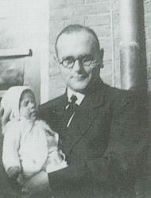
Herman Marinus de la Parra, with Els or Mieke(picture: Joods monument)
- Herman Marinus de la Parra, 24 September 1909, brother of Hans and Max. Doctor. The Joods Monument has a picture of him, from the book J.H. Coppenhagen, 'Anafiem Gedoe'iem. Overleden joodse artsen uit Nederland 1940-1945' (Deceased Jewish doctors from Holland 1940-1945, Rotterdam 2000). The Memorial Volume Mauthausen (1995) dedicates a paragraph to him.
After primary school Herman went to the Third 5-year HBS (higher secondary school) at the Mauritskade in Amsterdam. He excelled. Rather than making homework he played the saxophone, to him a symbol of modern life. He also played the piano beautifully. From childhood on Herman was extremely helpful. His choice to study medicine followed that line.
Doctor
He went to Leiden where he passed his doctors exam in 1933. After that he became a municipal doctor in Drenthe, in Emmen. On 9 May 1935 Herman married Willy Benjamins. In 1936 Els was born, in 1937 Mieke. She remembers her father singing songs with them. Around 1938 also the Jewish Surinam doctor-pharmacist Max Samson came to Emmen. He also worked as a municipal doctor. During mobilisation De la Parra served as health officer in the Dutch army; his practice was looked after by another doctor. This observer and Willy de la Parra had a relationship, which lead to the divorce between Herman and his wife. She moved with the girls to her mother in Amsterdam.
War
The German occupier soon started anti-Jew measurements. On 22 November 1940 Emmen fired both Jewish doctors as municipal doctors, giving the care for the poor. On 1 May 1941 they were only allowed to work for Jews; hardly a Jew lived in this area. Instantly they were without means of support. Samson went to Assen, De la Parra moved to Bussum, Graaf Janlaan. He started a practice 'only for Jewish patients' (Joodsch Weekblad - Jewish Weekly). Shortly after that he remarried to the widow Greet Czopp-Jerosolimsky (Rotterdam, 15 December 1910). She was a manufacturer and had a daughter about the same age as Els and Mieke. Their last known address was in Naarden, Rembrandtlaan 49. During the summer of 1942 Herman and Greet were areested after betrayal of a neighbour. At the time they probably weren't living anymore at their own address, but wanted to pick up some things to store. And Herman also illegally had a radio. Hermans brother Max, a dentist who lived with them, and Greet's daughter escaped the arrest and went in a hiding place.
Camp Amersfoort
Greet de la Parra-Jerosolimsky was transported to camp Westerbork, Herman was punished with camp Amersfoort. Though he stayed there for hardly three months, he attracted attention because of he was very helpful. Dr. L. de Jong writes about it in part 8-2 of The Kingdom of The Netherlands during the Second World War (p. 572 and 284). Frans Goedhart, founder of the Parool (newspaper), attracted dysentery. The supervisor of the sickbay was a communist prisoner who didn't care. The camp doctor, from the NSB (National Socialist Movement Party which collaborated with the Germans) had him taken to the ward. There De la Parra was working. Herman pinched opium from the SS stack and thus saved Goedharts life. Another prisoner, G. Tuynenburg Muys, was very dissappointed by the behaviour of well-educated inmates like notaries, doctors, vicars, chapelains and civil servants, with the exception of two young vicars and one 'noble Jewish doctor'. Probably this was Herman de la Parra.
Death
Greet de la Parra died on 30 September 1942 in Auschwitz, 2½ months after the start of the deportations. She was 31 years old. Herman Marinus died a week later, on 6 October 1942, in the infamous Austrian penal camp Mauthausen. He was 33 years.
Daughters
Together with their mother Els and Mieke lived at their grandmother Benjamins at the Stadionweg in Amsterdam. At some point Willy Benjamins was run in and brought to camp Westerbork, after which the family thought it wise to get the children to a hiding place. It was pure luck they weren't arrested also: the little room where they sat in was missed out. Els and Mieke both stayed in Brunssum, with different families. Willy Benjamins, who wasn't married anymore to a 'full Jew', managed to convince camp commander Gemmeke of Westerbork, she wasn't Jewish. A non-Jewish cousin, had provided a large number of her family a so-called Calmeyer-sperr, proving them non- or partly Jewish. This made her claim credible. After three quarters of a year in Westerbork, she came back to Amsterdam. Els and Mieke turned up again and together with their mother they lived through the hunger winter in Amsterdam. Greet's daughter also survived. After the war she went to an aunt in Israel.
Sources:
- Ad van den Oort, Allochtonen van nu & de oorlog van toen, p.59-60
- H.E.D. Dominicus en Alice B. van Keulen-Woudstra, Mauthausen Gedenkboek (1999), second edition p.118
- www.joodsmonument.nl
- 'Niet van gisteren', letter book Jewish Welfare Work, p. 49-50
- Conversation with Mieke van Praag-de la Parra (June 2008)
De la Parra-Samson couple
S # Henry René Gustaaf de la Parra, 10 August 1881, brother of Marinus Alfred de la Parra (see above). Husband of Judith Samson (see below). Henry René was a doctor and had also worked in the Netherlands Indies, where their four children were born. He died on 16 February 1941. At that time doctor de la Parra was doctor-inspector of the Rotterdam Council of Labour.
Source:
www.ntvg.nl, Nederlands Tijdschrift voor Geneeskunde 85.1.8 (22 February 1941)
- Judith de la Parra-Samson, 21 July 1884, wife of Henry René Gustaaf de la Parra. Judith was one of the four Samson sisters. The couple had four children: Henry Johan ('Hans') Louis, René Helène, Juliette Sophie and Marinus Gustaaf. Two daughters survived the Shoa. Her last known address was Goudsbloemlaan 29 in The Hague. Judith de la Parra-Samson was taken away on 31 January 1944. She died in Auschwitz, on 1 October 1944, on the same day as the two daughters of her nephew, Henry Jacques. She was 60 years old. A housemate survived the war, probably daughter Juliette.
-[] Henry Johan Louis (Magelang, 3 November 1910) lived with his wife Esther van Raalte at the Theresiastraat 322, The Hague. He died in Upper Silesia, October 1944. Esther survived.
- René Helène de la Parra (Netherlands Indies, 6 January 1912. Died 24 August 1993 in Leiden
- Juliette Sophie de la Parra (Netherlands Indies, 2 April 1914)
-[] Marinus Gustaaf (Batavia, 23 October 1920) lived in Deventer, and was murdered on 29 August 1942 in Auschwitz.
Source:
- www.delaparrafamily.com
- + Victorina ('Victorine') Albertina Polak-Pinto, born 31 October 1866, married to Jozef/Joseph Ar(r)on Polak (Paramaribo, 21 September 1852; 1859 according to the Amsterdam City Archives). From this marriage (22 August 1883) three children were born: Herman Julius (1884, see below), Betsy Nelly (1886) and Jacques William (1890). In November 1921 Joseph and Victorine Polak moved to Amsterdam, Weteringschans 73. Eight years later their daughter married the famous actor and director Adriaan van der Horst (see above). In November 1935 the moved in with them at the Van Baerlestraat 150-top. There Joseph Aron died on Christmas Eve 1938. Victorine was a lot in contact with her cousin Anna Semmeline Polak (see below).
War
After the start of the war mother and daughter registered themselves at this address as being from 'Jewish blood'. Betsy died in January 1942, Adriaan van der Horst in June that year. Victorine Polak-Pinto was now alone. She died in the gas chambers of Sobibor, on 7 March 1943. She was 76 years old. According to Joods Monument there was a housemate who survived. In Amsterdam-Slotervaart a street is named after Adriaan van der Horst.
Calmeyer
Her cousin Jules Samuels, son of Rosette Samuels-Pinto, was able to 'prove' in 1942 a non-Jewish descent. The parents of Rosette and Victorina, Jacob William and Abigael Izak Pinto, were in 1871 on a business trip - he was a merchant - in Georgetown, province of Demarara in British Guyana. There four young children stayed behind in Paramaribo. But the parents died in Georgetown of typhoid. They were buried at a Presbyterian cemetary. Rosette's son Jules received in 1942, all in good faith, from the Dutch consul in British Guyana the sworn in statement that the couple Pinto without any doubt had been Presbyterians and not Jewish, also because there was not a Jewish community in Georgetown at the time. On basis of this declaration Jules Samuels with his family obtained on 3 September 1942 a statement from the well-known German lawyer and civil servant dr. H.G. Calmeyer, stating there were no Jewish parents and at most two Jewish grandparents, therefore postponing an investigation. They were also of mixed marriage. They survived. It is not clear why Victorina, her son Herman and his family did not use the same document.
Sources:
- Mrs. S. Vetter-Samuels
- Digitaal Joods Monument and Community
- Family card City Archives Amsterdam
- www.nljewgen.org/golde/sprincie/2232.htm (Jozef Aron Polak)
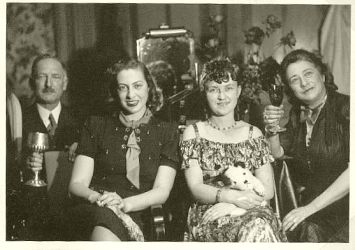
Herman Polak, Elly Orlow-Polak, Annemarie Samuels-Vosgerau and Carolina Polak-Wessel (1939)
(Picture: Mrs. S. Vetter-Samuels)
- + Herman Julius Polak, 13 July 1884, merchant. He was the eldest child of Jozef Ar(r)on Polak and Victorina Polak-Pinto (see above) and already soon left for Holland. He married Carolina Margaretha Wessel (Amsterdam, 2 August 1891). The couple had two children: Elize Betsy ('Elly') (Amsterdam, 8 April 1913) and Frits Herman (13 April 1919). In 1935 the family lived at the Velasquezstraat 6. On 25 January 1938 Elly married Michael Waldemar Orlow (Berlin, 23 August 1911). He died almost two years later in Lausanne (22 December 1939).
Samuels
In the picture Elly is sitting next to Annemarie Samuels-Vosgerau. She is the second wife of Jules Samuels (married 1935), an uncle of Elly, and she was not Jewish. Herman Polak helped his cousin Jules when he established himself as a doctor in Amsterdam (1936). He could stay in the former house of Herman's parents at the Weteringschans 73. It was Jules who received 'proof' in 1942 from British Guyana that his grandparents, the parents of Rosette and Victorina Pinto, were non-Jewish (see above).
War
In February 1941 the Polak-Pinto family lived together at the Minervalaan 70-III in Amsterdam, but went into hiding later on. As a widow Elly was not protected during the war by her mixed marriage. The hiding place was betrayed and only Frits survived. He was at another address, in Friesland. Carolina Margaretha died in Auschwitz on 6 September 1944, at the age of 52. Herman Julius died in concentration camp Gross Rosen on 7 February 1945, at the age of 60. Elly Orlow-Polak (Amsterdam, 8 April 1913) died on 21 March 1945 in Auschwitz, when the camp was already liberated for eight weeks. She was 31 years old.
Calmeyer
It is unclear why Herman with his family did not use the proof of non-Jewish descent which was in his family's posession (see above). Sonja Vetter-Samuels, daughter of Jules Samuels and Annemarie Vosgerau, writes: 'Probably my father did not yet possess this proof when Herman and his family went into hiding and next were betrayed. They were sent immediately via Westerbork to Auschwitz as a S-case (punishable case).' It could also be that Herman thought it to be too risky for him and his entire Jewish family to start this proces of 'Aryanation' through Calmeyer, as he had already twice refused the application by Jules.
Sources:
- Mrs S. Vetter-Samuels (2011, March 2014)
- Digitaal Joods Monument and Community
- Family card City Archives Amsterdam
- www.nljewgen.org/golde/sprincie/2232.htm (Jozef Aron Polak)
- www.jodeninnederland.nl/id/P-5302
- www.kwakzalverij.nl/370/Addendum_bij_biografische_schets_Dr_J_Samuels_no_2_van_de_Toptwintig
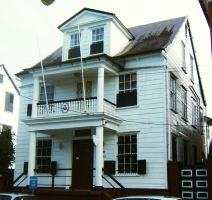
Waterkant 12 in 2007
Polak (-Levie) sisters
- Anna Semmeline Polak, 9 November 1875 (S writes 1874), daughter of Jacques Arons Polak and Grace Levie. In 1881 they bought the stately house Waterkant 12. Anna together with her sister Rachel and their brother Arnold were probably raised there. Jacques Polak died in 1908. The three children inherited and sold the house in 1920. Anne lived in Februari 1941 with her sister Richel in the G. Terborghstraat 42-I in Amsterdam. She was much contact with her aunt Victorine Polak-Pinto (see above). Anna Semmeline died on 5 October 1942 in Auschwitz at the age of 66.
- Rachel ('Richel') Martha Polak, 30 July 1878 (S writes 18 November). She lived together with her elder sister Anna in Amsterdam in the G. Terborghstraat in Amsterdam. She was murdered on the same day and place as Anna, on 5 October 1942 in Auschwitz. Rachel Martha was 64 years. Since 4 May 2006 her name is at the plaque on the war monument in Paramaribo (see Surinam in WWII).
Polak (-Gomperts) brothers and sisters
Polak-Arrias-Elte family
- Maurice Samuel (Semuel) Polak, 27 March 1887, pensioned district doctor. Son of Samuel Maurits Polak and Elizabeth Gomperts (see above: Judith Louise Nassy-Polak, 1892). Brother of Judith, Richel, Jacques and Louise Polak (see below). Widower of Estelle Arrias. Together they had in Suriname and the Antilles two children: Semuel and Thelma. These were probably the places where he was stationed as a doctor. After the death of his wife Maurice Polak married again, on 30 March 1927 in Alkmaar, to Henriette Elte (Alkmaar, 23 June 1902), a younger sister of Fijtje Elte, who shortly after became the wife of his brother Jacques. From the marriage with Henriette four children were born: Henri (1928) and Rebecca (1930) in Paramaribo, and Esther Henriëtte (21 May 1940) and Elie Meijer (4 April 1942) during his unfinished leave in Amsterdam. Their last known address was Karel du Jardinstraat 12-I in Amsterdam, next to the house where Maurice's brother Jacques lived. Exept for the eldest two children, who were murdered earlier on, the entire family was gassed on 3 September 1943 in Auschwitz. Maurice Samuel was 56, Henriette 41, Henri 15, Rebecca 12, Esther Henriëtte 3 and Elie Meijer 1 year old. Also most of the family members from the Karel du Jardinstraat were killed on that same day.
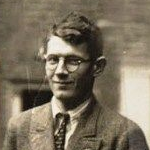
Semuel Polak (Source: Herbert Markus)
- Semuel/Samuel (according to S) Jacques ('Sem') Polak, Marowijne, 8 December 1919, eldest son of Maurice Polak and Estelle Arias. In the beginning of their marriage his parents apparently lived outside of Paramaribo. Semuel moved to Holland. Just like his sister Thelma he followed the Joodsche HBS (pre-university education). Both are on a school picture of 1937. Sem is all dressed up and wears a striking chain watch. He was killed in Sobibor on 28 May 1943. His sister Thelma died there early March. Semuel was 23 years.
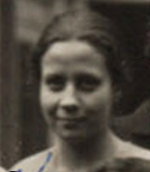
Thelma Polak (Source: Herbert Markus)
- [] Thelma Esther Polak, Saba (Netherlands Antilles), 19 December 1920, eldest daughter of Maurice Polak and Estelle Arrias. (See also the Antilles). Just like her brother she moved during the thirties to Holland. According to the school picture of 1937, Thelma was a student at the Joodsche HBS (pre-university education) at the Heerengracht in Amsterdam. Her last known address was the Central Israelitic Mental Home 'Het Apeldoornsche Bos', Zutphensestraat 106, Apeldoorn. She was probably, being the daughter of a doctor, a nurse in this home. From the site of Joods Monument: In the night of 21 - 22 January 1943 the Apeldoornsche Bos was 'emptied' (see Antilles, paragraph Antillian Jews).
Marriage in Westerbork
It is not known when exactly Thelma Esther Polak arrived in Westerbork. It is certain though she married in the camp on 2 February 1943. Her groom was Izak Cohen from the Watergraafsmeer (1919). Izak was a nurse and trained in the Beverwijk kibbutz and probably also in Laag-Keppel. His twin brother Joseph was witness to the marriage and also his cousin Berend Gustaaf (1907). Joseph had been a gardener hand at the Apeldoornsche Bos. He lived with his family in Apeldoorn. Both would have known Thelma. At that time she had no family members in the camp.
Sobibor
About a month after their marriage, Thelma and Izak were deported to Sobibor and gassed there on 5 March 1943. Thelma's brother Sem was murdered there eight weeks later.
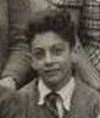
Henri Polak (Source: Herbert Markus)
- + Henri Polak, 30 June 1928, son of Maurice Polak and Henriette Elte. After the family moved to Holland, Henri first attended the public GLO school (primary school). After that he was a student at the Joodsche HBS, by that time moved to the Stadstimmertuinen. He is on the school picture of 1941 (picture). He died together with his father, second mother, younger sister, half-sister and half-brother on 3 September 1943 in Auschwitz. Henri was 15 years.
- + Rebecca Polak, 17 October 1930, daughter of Maurice Polak and Henriette Elte. Rebecca probably attended the BLO school (for children with special needs). She died together with her father, second mother, elder brother, half-sister and half-brother on 3 September 1943 in Auschwitz. Rebecca was 12 years.
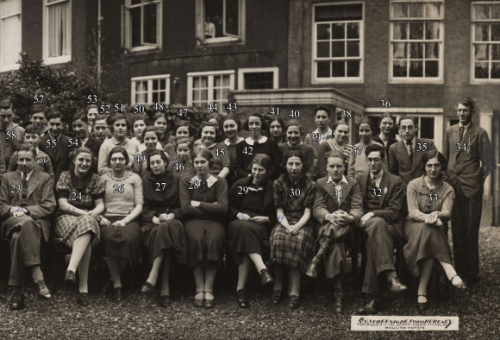
Joodsche HBS 1937 (part of picture). Number 34 is Semuel Polak, number 37 is Thelma Polak. (The numbers are digitally applied.) (Source: Herbert Markus)
With thanks to Roeland Oudejans-Albers (August 2017) and Herbert Markus (September 2010) - see also www.communityjoodsmonument.nl
Polak-Elte family
- Jacques Isidore Polak, 10 July 1898, teacher, brother of Maurice, (Judith), Richel and Louise Polak. He was married to Fijtje Elte (Alkmaar, 17 March 1894). In Amsterdam the couple had at least three children: the twins Rebekka and Esther (8 November 1928) and Salomon (29 January 1931). In 1941 the family lived in the Karel du Jardinstraat 10-I. Jacques Polaks' profession at the time was teacher at a secundary school. During that time also Jacques' sister Richel Mathilde, also a teacher, lived with them. Their brother Maurice lived in a house nearby. Fijtje Polak-Elte together with her three children was gassed in Auschwitz on 3 September 1943. She was 49 years, Rebekka and Esther were 14 and Salomon 12 years old. Also her sister Henriette Polak-Elte died there with her husband, daughter and four children. Richel Mathilde was gassed earlier, on 23 July in Sobibor. It was on the same day as her cousin Jules Henri Nassy. Jacques Isidore died at an unknown place, probably in a labour camp in Central-Europe, on 31 March 1944. He was 45 years.
Polak sisters
- Richel Mathilda Polak, 19 April 1895, teacher, sister of Maurice (Judith), Jacques and Louise Polak. In February 1941 she lived with her brother Jacques Isidore and his family in the Karel du Jardinstraat 10-I in Amsterdam. She died in Sobibor, op 23 July 1943. Richel Mathilda was 48 years.
- Louise ('Loetje') Estelle Polak, 11 November 1899 (S writes 18 November). Sister of Maurice, (Judith), Richel and Jacques Polak. Housemaid. In February 1941 she lived and worked in the Portugese-Israelite Old Mens Home, Nieuwe Herengracht 33 in Amsterdam. At that time there were sixteen residents, among them a twin of hardly a year old. Louise died in Auschwitz, on 19 Februari 1943, just as three elder residents from the home. She was 43 years.
- + Egbert Gustaaf Polak, 24 December 1872, engineer. His last known address was Merwedeplein 42hs in Amsterdam. Egbert Gustaaf Polak died on 20 June 1943 in the transit camp Westerbork, before he was being deported to a concentration camp. He is buried at the Jewish cemetary in Diemen. Egbert was 70 years.
Pos brothers
- + Hartog Joseph Pos, 16 August 1884. Dentist. Probably a brother of Samuel and Simon Pos. His last known address was Graaf Wichmanlaan 37 in Bussum. He was gassed op 4 June 1943 in Sobibor, at the age of 58. Of this household a JOKOS-file is known because of the robbery of valuables. Hartog J. Pos name is since 4 May 2006 mentioned as one of the 10 Holocaust victims on the war monument in Paramaribo.
- Samuel ('Sam') Joseph Pos, 3 January 1888. Dentist. Probably a brother of Hartog Joseph. Samuel died on 11 December 1942 in Auschwitz. He was 54 years old.
- S Simon Hendrik Pos, 11 October 1889. Dentist. Son of Joseph Handdik Pos and Jansje van West and brother of Sam Pos. His name is not on the sites of OGS, JM and In Memoriam.
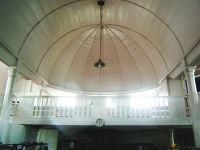
Portugese Synagogue, former balcony for the women, 2007
- + Rebecca Rachel Querido, 16 April 1894. She was the daughter of the religious teacher ('gazan') David de Isaac Querido (15 October 1868). He arrived on 8 November 1892 with the ss Prins Frederik Hendrik in Paramaribo. 18 Days later he held his first sermon in the Portugese Israëlitic Synagogue in the Gravenstraat. David Querido succeeded there Menasse Abarbanel. In 1893 Querido was on leave for a couple of months. He came back as a married man. His wife was Sara Pache. In April their daughter Rebecca was born. Sara's health was the reason the gazan was granted another leave in July of that same year. The couple went to Holland and never returned. Querido was honourably dismissed. Sara Palache died before 1905. In that year David Querido became a gazan at the Jewish congregation 'Mikve Israel' in Curaço. He remarried there with Estela de Mordechay Fidanque Curiel. In 1918 David Querido died. He was given the honorary title 'distinguished rabbi' ('haham hane'ela'). His wife Estela died in 1927. Rebecca became a translator and lived in The Hague. Her last known address was Frederik Hendrikplein 18. She died in Auschwitz on 11 October 1944. Rebecca Querido was 50 years.
- + Hanna Marie Reiss-Root, Paramaribo, 9 March 1888, widow. She was a daughter of Mozes Root from Amsterdam and Leentje Frank from Utrecht, who married in 1875 in Paramaribo. She was the fourth of nine children, the last one to be born in Suriname. The youngest brother, Marcus Jacques, died in 1898, only one month old. The eldest, Esther, died in 1937 and was buried at the Jewish cemetery in Diemen. For the third Surinam daughter, see Elisabeth Lea Zinger-Root.
Hanna Marie married Barend Reiss (1885) on 30 May 1912, a son of Abraham Reiss and Naatje Kirgheim. They lived at the Rapenburgerstraat 132-K. Barend worked as a traveling salesman, diamond cutter and lastly as a clerk. Their last known address was Tugelaweg 97hs, Amsterdam. There were five children. In 192 Naatje Rebecca was born, followed by Simon in 1913, Lena in 1915, Esther in 1916, Josephine in 1918, who died the same year in the Wilhelmina Gasthuis in Amsterdam. In 1920 Elisabeth was born, after that Abraham Mozes in 1921, Kitty in 1924 and another Josephine in 1927. Simon became a weaver, Esther seemstress, Abraham Mozes upholsterer and Kitty became a seemstress as well.
Just before the outbreak of the Second World War, on 21 March 1940, Barend Reiss died. He was buried at the Jewish cemetery in Diemen. Daughter Elisabeth married Louis Ferdinand Feibel, and the couple killed themselves on 15 May 1940. Hanna Marie and the six remaining children were murdered during the Sjoa in Auschwitz or Sobibor. On 22 July 1942 a movables list was made, containing only ladies and childrens clothing.
Esther Glasbeek-Reiss and her sister Kitty were gassed on 30 September 1942 in Auschwitz, the same day and place as 9 members of the Glasbeek family. Esther was 25 years, Kitty 17 years. Mother Hanna Maria and the youngest child, Josephine, were murdered on 19 November 1942 in Auschwitz. Hanna Marie was 54, Josephine 15.
Naatje Rebecca Nebbig-Reiss and her son Bernard were gassed on 3 December 1942 in Auschwitz; her daughter Mia a few days later, on 7 December; her husband Mozes Nebbig died after a couple of months of forced labour on 28 February 1943 in the Silezian camp Malapane, at the age of 29. His brother Abraham Mozes died on 28 February 1944 in Auschwitz. He was 22 years.
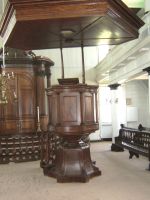
Pulpit of the Ashkenazy Synagogue, 2007
Roos-Prins family
- Samuel Roos, 19 September 1895 (S says 18 September), son of rabbi Roos. Traveling salesman. His father, Jacob Samuel Roos (1868), came to Suriname in 1893. His first sermon at the Ashkenazy Synagogue at the Keizerstraat was on June 29. Governor T.A.J. van Asch van Wijk attended the service. The congregation anxiously awaited the arrival of a new rabbi. After the early death of the brilliant supreme rabbi Lewenstein in 1864 - he served as well the German as the Portugese congregation and had a Protestant like pulpit installed in the Ashkenazy Synagogue to be more audible - services were led by merchant Samuel Israël Levie ('uncle Sjolom') and his brother and colleague Juda Israël Levie ('uncle Juda'). The first one had been an assistant prayer since 1848, Juda since 1864. Another reason to strengthen the congregation were the anti-Semitic rows in May 1891. Supreme rabbi of North-Holland I.H. Dünner recommended his student Roos. He had the title 'magid', preacher, and also was a circumsizer ('mohel') and a ritual slaughterer ('sjochet'). In February 1893 Jacob Roos was made rabbi of the NIG by the church council. On May 30 he married Selly Benjamins and shortly after the couple embarked. The pair went to live in the official residence at the corner of the Keizerstraat and the Zwarthovenbrugstraat. The government allowed the rabbi a yearly pay of 1,750 guilders. On 17 July 1894 daughter Debora ('Della') was born, over a year later Samuel. Jacob Roos and his family stayed in Suriname for 17 years. Roos was known as a great orator. On 25 May 1912 was the farewell service. Because of his merits Rabbi Roos was rewarded a knighthood in the Order of Orange. Until May 1940 he received a pension of 538 guilders a year. After his return to Holland the rabbi remained active in the Amsterdam and Dutch Jewry, also as a preacher of Talmud Thora at the Plantage Middelaan in Amsteram.
Daughter Debora (see below) married doctor Daniël J. Samuels. Son Samuel married to Keetje Prins (Amsterdam, 28 January 1903). The couple had four children: Selly (Amsterdam, 1 December 1927), Esther (idem, 31 December 1929), Della Clara (idem, 17 July 1931) and Jacob Salomon (idem, 6 December 1934). The entire family was murdered on 8 October 1942 in Auschwitz. Samuel was 47 years, Keetje 39 years, Selly 14 years, Esther 12 years, Della 11 years and Jacob 7 years old.
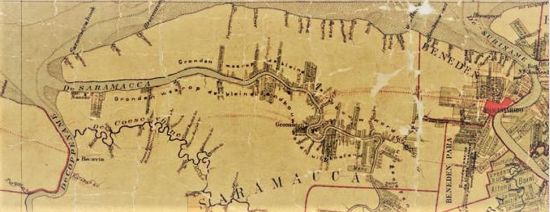
Map Beneden Saramacca, Cateau van Rosenfelt (1860-1879). Source: blogspot Arkhamarchivaris 2012-01
- Abraham Hartog Root, 23 juli 1881, Post Nassau in the district of Beneden Saramacca. Nassau was a militairy post near the mouth of the Saramacca river at the Agenoria plantation. Until the thirties there was no road to Paramaribo (far right on map). He was the third child of Mozes Root and Leentje Frank; before his Surinam sisters Elisabeth Lea and Hanna Maria (see above and below). His father possibly was a militairy. Abraham Hartog was a flower merchant by profession and married in 1911 in Amsterdam to Leentje de Leeuw. She was a daughter of Abraham de Leeuw and Sara Goudsmit and was born in Haarlem (1883). The couple Root-de Leeuw had no children. After the marriage the couple lived at the Raamgracht 9 in Amsterdam, moved on 4 January 1912 to the Oude Zijds Achterburgwal 49 and eight months later to the Groenburgwal 38. In August 1930 they moved to the Kerkstraat 39 and on 6 Augustus 1938 their address became Thorbeckeplein 18 III in the centre of Amsterdam, what was to become their last known adress. On 12 November 1942 both were transported to camp Westerbork. In the register of the Jewish Council is mentioned that they had 'no religion'. Four days later they were transported to Auschwitz. On arrival on 19 November Abraham Hartog Root and Leentje Root-de Leeuw were immediately murdered.
- S Esther Samson, 23 January 1886, daughter of Jacob H. Samson and R.M. Bueno de Mesquita. None of the Holocaust-sites carries her name.
- + Flora Marianna ('Marianne') Samson, 8 June 1875. Her last known address was Westerhoutpark 18, Haarlem. Flora Marianna was gassed on 9 July 1943 in Sobibor. She was 68 years. The name of Flora M. Samson is mentioned at the plaque of the war monument in Paramaribo since 4 May 2006. She was the oldest of the four Samson-Samethini sisters.
- JS Helena Esther Samson, 21 January 1886. John Stienen brought her name to our attention (e-mails Nov. 2020). Helena was a younger sister of Flora (1875), Sophie Jacobsen-Samson (1885) and Judith de la Parra-Samson (1884) (see above). She is in the migration register of 1909 and in the archive of the provincial hospital in Castricum as coming from Zeist on 25 July 1918 (wiewaswie.nl). Helena was a teacher. Op 13 May 1921 she was deleted from the register as moved to Apeldoorn, 'afdeling Bosch'. The war address known to the Jewish Council was that of her brother in law De la Parra, who lived at Ungerplein 2 in Rotterdam. He died on 16 February 1941. It is not known yet how Helena Esther fared. Her personal details are almost the same as of Esther Samson (see above). Her death has not been determined by the Commision for Declaration of Death of Missing Persons, which after the war has determined the fate of Dutch inhabitants who did not return from the camps.
Samson-Ezechiels family
- Marcus ('Max') Abraham Samson, 11 October 1904, son of chemical analyst A.Ph. Samson. Doctor. He married to Daisy Henri&235;tte Ezechiels. The couple had two children: 'Philli' and 'Annie'.
The site of Joods Monument writes: 'Marcus Abraham Samson came in the late thirties from Paramaribo to The Netherlands, probably in the posession of a doctors certificate. He settled down in Emmer-Erfscheidenveen (Emmer Compascuum) as a pharmacist-doctor. In 1941 he passed his Dutch doctors exam. Since June 1941 he practiced from the Vondelstraat 11-a in Assen'. In April 1942 also the couple Stern-Magnus and a child lived there.
Ad van den Oord ('Allochtonen van nu en de oorlog van toen' - see Suriname, paragraph Surinam intellectuals) gives more background information: 'Max Samson settled down just like Herman de la Parra (see above) as a general practitioner in Drenthe. Herman served during mobilisation as an officer of health in the Dutch army; Max took care of his practice. The German occupier started very early with anti-Jew measures. On 22 November 1940 Emmen fired both doctors as community doctors, given the care of the poor. On 1 May 1941 they could only work for Jews; hardly any Jew lived in that area. Instantly they were without means of support. De la Parra moved to Naarden, Samson tried to persuade an alderman, but in vain. On the 10th of June he moved with his family to Assen, where a small Jewish community was'. The Samson family was deported to Westerbork and from there to Auschwitz. Max Samson was put to work and stayed alive until 28 Februari 1943. He was 38 year.
- Daisy Henriëtte Samson-Ezechiels, 17 May 1901, daughter of Benjamin Ezechiels and Anna Robles. Wife of Marcus Samson. On 8 May 1938 in Emmen Philip ('Philli') Marcus was born. On 12 September 1939 Hanna ('Annie') Harri&235;t followed. The family was forced to leave Emmen. From Assen, Vondellaan 11a, they were transported to Westerbork and early December 1942 to Auschwitz. Max Samson was selected for work. Daisy Henri&235;tte and her two children were sent to the gas chambers. They died on 11 December 1942. Daisy was 40 years, Philip 4 years and Hanna 3 years old.
- <> + OGS Aron Esriel Samuels, 30 November 1870. Netje Levie-Samuels (1862), Rosetje Bramson-Samuels (1868), Selly Alexander Gomperts-Samuels (1869), Bernhard Eduard Samuels (1872) and Marianne Machiel van West-Samuels (1888) probably are relatives. Aron Esriel died on 17 January 1944 in Batavia, 73 years old. He was buried at the Dutch honorary cemetary Leuwigajah in the Netherlands-Indies.
- + Bernhard Eduard Samuels, 10 November 1872. Officially his name was Bernar Esriël Samuels and probably he is a younger brother of Aron Samuels (see above). Bernard was a musician, he played the flute. Because of his many performances abroad, he decided to change his name Esriël to Eduard. He was married to Sophia Hester Zendijk (aKampen, 23 Deember 1872). The last known address of the couple was Louise de Colignyplein 19 in Zeist. Bernard Eduard died on 22 July 1944 in Theresienstadt, his wife Sophia died there on 5 April 1945, just before the liberation of Theresienstadt.
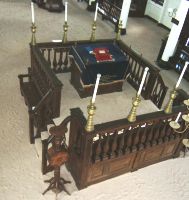
Lectern Ashkenazy Synagogue, 2007
- Selly Elisabeth Samuels, 31 July 1886, daughter of Jacob Samuels and Flora Pos. Selly Samuels worked as a civil servant at the governmental State Secretary. In The Netherlands she was an office clerk. Her last known address was the Van Eeghenstraat 57hs in Amsterdam. This was a boarding house of Georg Herzberg (Aerzen, 1883) with ten rooms. Exept for seven Jewish single persons in February 1941, there also lived the elderly Surinam couple Fernandes-Swijt (see above). Selly Elisabeth died on 6 March 1945 in Bergen-Belsen. She was 58 years old.
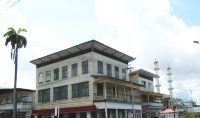
Former official residence of rabbi Roos in 2007
- Debora ('Della') Samue[ë]ls-Roos, 17 July 1894 [the site of Joods Monument spells a diaereses on the e]. Daughter of rabbi Jacob Roos and his wife Selly Benjamins, sister of Samuel Roos (see above). A year after arrival of her parents in Suriname, Debora was born. The family returned in 1912 to The Netherlands. Della married doctor Daniel J. Samuels. Her last known address was Kennemerstraatweg A 464 in Heiloo. At the time she was a widow. Debora died on 11 Februari 1944 in Auschwitz, 59 years old.
- Betsy Elmire Sanders-Fernandes, 9 March 1893, daughter of Uria Fernandes, butcher (at S known as Betsy Fernandes). Betsy married to Salomo Sanders (Wildervank, 17 July 1889), traveling salesman. There were at least two children: Frouwke (Groningen, 21 May 1926) and Helena Commy (idem, 24 May 1929). In June 1944 the family still lived in the Otto Eerelmanstraat 9-a in Groningen. The parents and the youngest daughter were murdered on 7 July 1944 in Auschwitz. Salomo was 55, Betsy 51 and Helena 15 years old. Frouwke probibly lived to see the liberation of Auschwitz, but died on 28 February 1945 at an unknown place. She was 17 years old.
Da Silva children
- Izaak/Isaak (with S) David da Silva, 9 February 1877 (S writes 18 February), child of David da Silva and Esther Samuels, brother of Arnold da Silva (1879) and Betje Lopes de Leaô Laguna-da Silva (1882). Last known address: Bronckhorststraat 11-I, Amsterdam. Izaak David was killed on 7 July 1944 in Auschwitz. He was 67 years. Of this household claims are known because of robbery (JOKOS/LIRO).
- Arnold David da Silva, 5 January 1879, doctor. Brother of Izaak da Silva (1877) and Betje Lopes de Leaô Laguna-da Silva (1882). Arnold married to Anna Palache (Amsterdam, 27 April 1883). There was at least one child, Ellen Reina (idem, 6 January 1920). She became a teacher. Their last known address was Sarphatistraat 161hs, Amsterdam. Anna da Silva-Palache was murdered on 7 July 1944 in Auschwitz; she was 61 years. Arnold David in the same camp on 31 July 1944, 65 years old. Ellen Reina died on 28 February 1945 at an unknown place; when she was in Auschwitz she will have seen the liberation of the camp. She was 25 years.
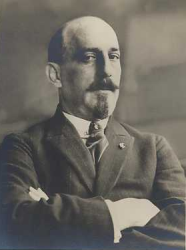
Julius da Silva (Source: www.joodsmonument.nl)
- Jehuda Jacob ('Julius', 'Jules') da Silva, 12 September 1882, son of Jacob da Silva (1847-1922) and Jacqueline Brandon (1850-1916). The couple had nine children: Isaac Jakob (1874 - Curacao, 1954), Samuel Jacob (1875), Rachel Jacob (1877), Estell Jacqueline Jacob (1879), Juan Abraham Jacob (1881), Jehuda Jacob, David Jacob ('Tips')(1884), Mathilde Elisabeth Jacob ('Tilly')(1886) and Helena C. Jacob ('Lena')(1888). Both parents died in The Hague.
In December 1902 Jules was registered in Amsterdam, coming from Hilversum. In 1907 he came from Paramaribo to the capital. A year later he married in Amsterdam to Caroline Vaz Dias (Amsterdam, 28 November 1885). They had one child, Paul. Together with a brother in law of his wife, Justus Lissauer, Jules became co-owner and director of the news agency M.S. Vaz Dias, the precursor of the ANP. The new agency was established by Caroline's brother Maurits and Justus Lissauer in 1904. From 1817-1918 Jules was a freemason at the Amsterdam lodge 'La Bien Aimée' at the Vondelstraat. He was also a member of the artists society De Kring. In 1930 he was knighted in de Crown Order of Belgium. He also received other high distinctions. His last known address was the Jacob Obrechtstraat 43 in Amsterdam. Jules da Silva died on 4 August 1942 in Auschwitz (S writes Amersfoort). The deportations started only three weeks before. Jules da Silva was 59 years. His wife Caroline died in October 1944 in the same camp. His younger brother Samuel Jacob escaped deportation, but died during the war (see below). His co-director Justus Lissauer died on 24 September 1943 in Auschwitz.
Sources:
- Database Jewish Biographical Dictionary (www.jodeninnederland.nl/id/P-5231)
- http://home.tiscali.nl/~dasilva/voorouders/vooroudersmarcel.htm
- http://sefardies.es/ficha_biografias.php?id=12785
- S David Jacob ('Tips')da Silva, 24 December 1884. Brother of Jules and Samuel da Silva (see elsewhere). He died on 28 May 1952 in Amsterdam. David married twice and had no children (with thanks to Tom Hoornstra, April 2014)
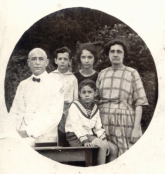 | 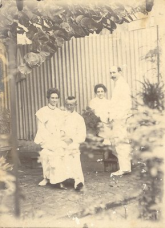 | 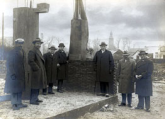 |
Samuel, Céline,
Netty and two sons da Silva
in The Netherlands, around 1930
(Source: suriname-dasilva.blogspot.nl) | Samuel and Céline
in Paramaribo, JanuarY 1905
- right couple
(Source: suriname-dasilva.blogspot.nl) | Samuel da Silva (3rd from left)
laying the first
stone of the post office
Oostvoorne, 20 January 1933
(Source: www.joodsamsterdam.nl) |
- Samuel Jacob da Silva, 4 December 1875. Samuel Jacob da Silva was a son of Jacob da Silva and Jacqueline Hobeb Brandon and brother of Jehuda Jacob and David Jacob (see above). In 1905 Samuel married Céline Jacqueline Bueno Bibaz (1 August 1882 - 3 April 1954). Her mother, Annette Carolina Kennedy, was non-Jewish. Samuel self would later change over to the Nederlands-Hervormde Kerk (Dutch Reformed Church). Even being a 'geschmad' he stayed proud of his Jewish descent. Already in Suriname he became district commissionary of Coronie in 1917 and in 1920 of Upper-Para. Then he moved with his family to the Netherlands. From 1924 until 1932 Samuel was mayor of Zwartewaal, at that time the smallest city in Zuid-Holland. The family lived in Den Briel. In 1932 he became mayor of the larger and more complex Oostvoorne. Samuel was one of the few Jewish mayors before the war. In 1938, at the age of 63, he retired. His administrative career came to an end because of his delicate health. The couple moved to The Hague. They had a daughter, Nettie Jacqueline (1907-1952) and three sons. Cé being of half-Jewish descent and having the Reformed religion, the nazis saw this as a mixed marriage. Samuel was also confronted with the limits and risks of mixed-married Jews during the war, but was not deported. He died in The Hague on 6 July 1943. At that time his brother Jules had already been killed in Auschwitz. Jules' wife and children survived the war.
Sources:
- Digitaal Joods Monument and Community (here is the date of death 3 July 1943)
- Database Jewish Biographic Dictionary (www.jodeninnederland.nl/id/P-5231)
- www.joodsamsterdam.nl/rotterdam/perssamueldasilva.htm
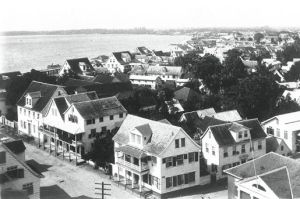
Centre town seen from the Oranjeplein (Independance square) around 1915 (picture: Augusta Curiel: www.engelfriet.net)
- + Bilha ('Betje') Isaak Souget-Citroen, 30 July 1874, widow. She probably came from the same family as Jacob Isaak and Barend Isaac Citroen (see above). Her last known address was Joh. Verhulststraat 131hs, Amsterdam. She lived there together with three Jewish housemates: another widow, a seamstress and a maid-servant. Bilha Isaak Souget-Citroen was gassed on 5 February 1943 in Auschwitz. She was 68 years. Of her household claims are known (JOKOS and LIRO). Her housemate, the widow Mietje de Lange-Mendels died at the same day and place.
- Celine (Seline) (with S) Telline Swijt, 1 August 1905. In February 1941 she lived together with her mother, Dina Swijt-Vas Nunes (Amsterdam, 9 March 1877), at the Zuider Amstellaan 56-I in Amsterdam - named Rooseveltlaan after the war. Rebecca Fernandes-Swijt (1870), Jansje Parra-Swijt (1884) and Cornelia Tellina Vas Nunes-Fernandes (1896), are probably related. Celine Telline Swijt was murdered on 23 April 1943 in Sobibor. She was 37 years. Her mother died in Auschwitz, on 11 February 1944, 66 years old.
Tay(ij)telbaum-Levie couple
- Jacobi ('Jacob', 'Boy') Machiel Tay(ij)telbaum (the three victim sites write Taijtelbaum), 18 January 1896, son of Samuel Isay Taytelbaum and Seline M. de Vries. Della Julietta Cahen-Taytelbaum (1872) was the sister of Samuel Isay (see above).
Just like his father Jacobi was born in Paramaribo, but went in his youth to Europe. He lived in Amsterdam and in Berlin. Back in Suriname he became a merchant and industrialist, with interest in agriculture and gold mining. From his marriage to Seline de Vries at least two sons were born, Jacob and Max. When he was older Samuel Isay studied Hebrew to follow the services in the synagogue more easily. Between 1895 and 1917 he was a member of the Poor Men's Board of the NIG, many years as a chairman. From 1919 on he was a member of the church council, until his death in 1939.
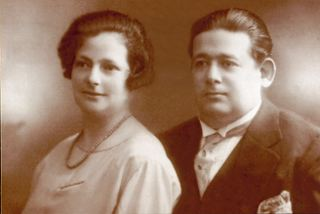
Couple Taytelbaum-Levie (source: George Taytelbaum)
Jacobi Taytelbaum married to Blanche Levie. Since 1929 Jacob worked as a banker in Amsterdam. There, on 19 november Jacob and Blanche were married. After this they emigrated to New York, where Jacob will have worked for his bank. From 1934-1937 the couple lived at the Amstelkade 93 in the capital, and then moved to the Kade A9 in Veere (province Zeeland), next to Jacobs brother Max. Jacob had taken a German Jewish refugee boy in his house. When Jacob Machiel tried to escape the German occupier, he wasn't allowed to cross the Dutch-Belgian border with the boy, because he had the German nationality of the enemy (information by nephew George Taytelbaum, November 2005). The last address of the couple was Zuider Amstellaan 15 in Amsterdam (1942). The Jewish citizens in the province of Zeeland, as well as many of them in the province of Noord-Holland and from Delfzijl, were forced (early 1942) to 'evacuate' to Amsterdam and Westerbork. For the province of Zeeland this was in March. Jacob Machiel died in Auschwitz, on 1 October 1942. He was 46 years. Blanche was murdered a year later. His brother Max survived the war, was a medical practitioner in Curaço and died in Israel.
Extra source of information: Henk Muntjewerff, June 2012
- Blanche Tay(ij)telbaum-Levie, 29 March 1896, daughter of Juda Levie and Grace Gomperts. She married to her fellow citizen Jacobi Machiel Taytelbaum and together they lived in Veere (The Netherlands). Blanche died at another day and place than her husband. Her last adress was Deurloostraat 104 hs in Amsterdam. In 1941 at this adress also lived the family of Judith Nassy-Polak and the couple Bueno de Mesquita-Bueno de Mesquita (see above). Blanche was gassed on 11 June 1943 in Sobibor, at the age of 47. In September 2011 there was a non-remitted life insurance on her name (www.stichting-sjoa.nl/nedPolissen.html#t).
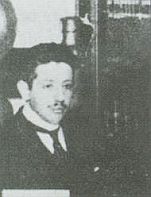
Emanuel Haim Vas Nunes (picture: Joods Monument)
- Cornelia Tellina Vas Nunes-Fernandes, 14 March 1896. She married to Emanuel Haim Vas Nunes (Amsterdam, 6 December 1884), doctor. The site of Joods Monument tells about him: 'Emanuel Haim Vas Nunes studied medicine in Amsterdam, where he passed his doctors exam on 17 February 1912. He specialized in skin and venerial diseases. He lived and practiced at the Lairessestraat 60 in Amsterdam. He also had a practice in the Dutch-Israelite Hospital (Nieuwe Keizersgracht 110) and at the polyclinic for venerial diseases (Westerpark 2). Emanuel Haim Vas Nunes was a regent of the hospital 'Mesib Nefis'.
The couple had two children. David Daniel (Amsterdam, 25 Februari 1918) studied medicine in Amsterdam, where he passed his masters degree. Their last known address was De Lairessestraat 80 in Amsterdam. Cornelia Tellina and Emanuel were murdered on 14 October 1944 in Auschwitz. She was 48, he was 59 years. Their son David was killed two weeks earlier, on 1 October 1944, in the same camp, 26 years old. One child survived the war. Of this family claims are known concerning bonds and valuables.
- Marianne ('Marie') Machiel van West-Samuels, 21 January 1888, wife of John van West, mortgage insurer. See for possible relatives Selly Elisabeth Samuels (1886) and other members of the Samuels family. Her father in law was doctor Izaak van West, who promoted in 1870 in the Netherlands in medicine and passed his doctors exam. Friends in Suriname founded a Health Service ('The useful precaution') to keep him as a doctor for Suriname. He stayed and especially distinguished himself as an obstetrician. Izaak van West advocated the establishment of a Medical School in Suriname and became one of its teachers. He died in 1911. His son John van West also studied in The Netherlands and became a candidate-notary. For years he was a mortgage insurer in Suriname. After his untimely death, on 8 March 1934, his wife Marie van West-Samuels moved to The Netherlands. Her last known address was Nicolaas Maesstraat 97hs, Amsterdam. Here she lived together with the landlady and an aged man, both also Jewish. Marianne Machiel van West-Samuels died on 27 August 1943 in Auschwitz. She was 55 years. Her two children living away from home survived the Sjoa.
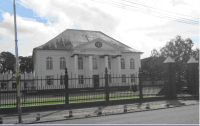
Dutch-Israelite Synagogue in 2007
[] Jakob de Wilde (Sneek, 2 April 1874) - (De Bye, Outlines, writes Jacob, born on Pesach 1st, with the (wrong) year 1875). His wife was Hanna ('Hanny') Smeer (Schoterland, 16 May 1876). Late October 1896 De Wilde came to Suriname to become, at the age of 22, prayer ('gazan'), slaughterer ('sjochet') and later also circumsizer ('mohel') at the NIG. Three years before the Ashkenazy Congregation became a new rabbi, Jacob Roos. De Wilde succeeded assistent-prayer and merchant Salomon Israel Levie who, as 'uncle Sjolom' had been a gazan for 48 years. After five years De Wilde returned to The Netherlands (July 1911). In November 1912 he was back again, as a temporary teacher in the vacancy of Roos. Meanwhile he probably had married to Hanny Smeer. On 1 December 1913 Jakob de Wilde was appointed permanently. During this second period Jakob was almost for fifteen years a teacher of the NIG. In February 1927 he was declared unfit for further services in the tropics. He was awarded a yearly pension of 637 guilders. In The Netherlands De Wilde was gazan in Elburg and from early 1929 in Tilburg. At the outbreak of war he probably was retired.
Former gazan De Wilde and his wife probably were deported late 1942. This is known thanks to the stocktaking of their movables at the Willem II-straat 18 on 3 September that year (JM). The stocktaking preceded the eviction and was executed by order of the Hausraterfassung. Much of the robbed furniture was sent to Germany. Other officials or individuals also annexed property. The house had two living rooms and four bedrooms. In the attic one listed: 'useless things'. In the smallest bedroom the civil servant finds a 'backpak (packed)(2)'. So the couple was ready for the eviction to Westerbork. When they actually arrived there is unknown. The deportation to the destruction camp Sobibor was on 8 June 1943. Religious teacher De Wilde, who worked for over 20 years in Suriname, was gassed on 11 June 1943, the same day as his wife. He was 69, she was 67 years old.
- + Julius Wolff, 6 May 1910. Julius was married to a non-Jewish woman. They had four children. Their last known address was Lodewijk Boisotstraat 20I in Amsterdam. The couple were members of the resistance. They offered their attic as a safe place for German-Jewish refugees. They were betrayed by a neighbour. His wife and children were warned in time and found places to hide in The Netherlands. Julius Wolff died of typhoid in Dachau, on 4 February 1945. He was 34 years.
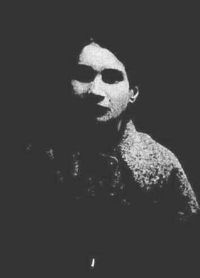
Elisabeth Lea Zinger-Root, 4 November 1921 (picture: Joods Monument)
- Elisabeth Lea Zinger-Root, 21 Juni 1879 in Post Nassau in Beneden Saramacca. Her name was brought to our attention by John Stienen. Elisabeth was a daughter of Amsterdam Mozes Root and Leentje Frank from Utrecht, who married in 1875 in Paramaribo. She was the second of seven children. Also her sisters Esther and Hanna Marie and her brother Abraham Hartog were born in Suriname - see above.
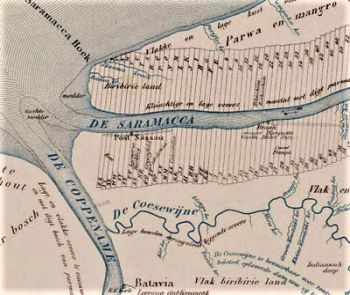
Post Nassau map of Cateau van Rosevelt 1860-79 (picture: blogspot arkhamarchivaris 2012-01)
When parents and children returned to The Netherlands in 1891 they lived for a short period of time in Amsterdam. After that the growing family moved to Arnheim, in 1892 to Rheden and in 1895 back to the capital. Elisabeth Lea married in 1903 to the 28-year old street trader Isaäc Montanhes, a son of Abraham Montanhes and Rachel da Silva Abenatar. The couple had a daughter in 1910, Femmie. The marriage did not last and was shortly after dissolved.
Elisabeth started living with diamond cutter Joseph Zinger, a son of Mozes Abraham Zinger and Femmetje Tonningen. The family lived in the Rapenburgerstraat 132, the old Jewish district, in the same house as Elisabeths younger sister Hanna Maria. Later on they moved to the Govert Flinckstraat 358 (indwelling with Andersen). Elisabeth and Joseph had four children: Mozes, Leentje, Abraham Joseph en Sarah. Also Femmie Montanhes was part of the family. Mozes and Leentje were called 'forechildren', because the marriage was made official only in 1916. In 1915-1916 Joseph stayed for over a half year in Brooklyn U.S.A.
Three years after the First World War, in October 1921, the family left for Antwerp. Because the family went to Belgium without visa and the Antwerp authorities did not make a 'proposal for domicile', they went back to Amsterdam in December 1921 where they found a place to live with the widow of Mordechay Morpurgo in the Eerste Oosterparkstraat 120. After that they moved about another six times, until in September 1934 they had a house of their own in the Hofmeyerstraat 5 III, also in Amsterdam-Oost. Meanwhile Mozes, office clerk, had developed psychological problems and was admitted in 1930 to the Centraal Israëlitisch Krankzinnigengesticht 'The Apeldoornsche Bosch'. His mother followed him from October 1933 until 1936, the year she was discharged.
During the German occupation most members of the family became victims of the Sjoa. In Amsterdam in 1934 Femmie Montanhes had married Jacques Leonhard Léon (1904) from The Hague. They lived in Amsterdam and in 1935 had a daughter, Geertrui. Jacques died in January 1940. Femmie and her daughter were registered on 23 July 1942 in camp Westerbork and deported on 31 July to Auschwitz, where they were killed on 2 August. Sarah, housemaid, was deported on 4 September 1942 from Westerbork to Auschwitz, where she was murdered immediately after arrival on 7 September.
Elisabeth Lea Zinger-Root was admitted again on 15 July 1942 at 'Het Apeldoornsche Bosch'. Together with her son Mozes and most other patients and members of staff, they were transported to Auschwitz on 23 January 1943 and gassed immediately after arrival. When his wife was admitted again Joseph Zinger moved to the Middenweg 201hs, a pensioners home from the nurse Fijtje Kischneider-de Groot. On 3 April 1943 he was run in and transported to Westerbork, from where he was deported on 6 April to Sobibor. Immediately after arrival on 9 April he was gassed. Mrs Kischneider died the same year on 2 July in the same camp.
Leentje Zinger, office clerk, and Abraham Joseph, warehouseman, survived the Holocaust.
Sources / More reading
All pictures by Pim Ligtvoet, unless noted otherwise.
John H. de Bye, Historische schetsen uit het Surinaams jodendom. Uitgeverij Conserve, Schoorl, 2003. (The book contains many of 18th and 19th century archives, especially of the Ashkenazy Congregation, the list of Holocaust victims of Teroenga and also some descriptions of careers of known and remarkable men of the Surinam Jewry, up to the 20st century).
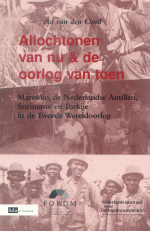
Allochtonen van nu & de oorlog van toen (Todays immigrants & latterday war - Morocco, the Netherlands Antilles, Suriname and Turkey in the Second World War
Ad van den Oord, SDU/Forum 2003, isbn 90-5409-420-6 (in Dutch)
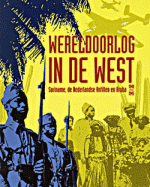
Wereldoorlog in de West (World War in the West - Surinam, the Netherlands Antilles and Aruba 1940-1945. Liesbeth van der Horst - Published by Verloren, ISBN 90-6550-794-9 (in Dutch)
Anne Frank Foundation
DutchJewry
Joods Monument
Lo Tisjkach
Oorlogsgravenstichting, information by mr. J. Teeuwisse
 |

